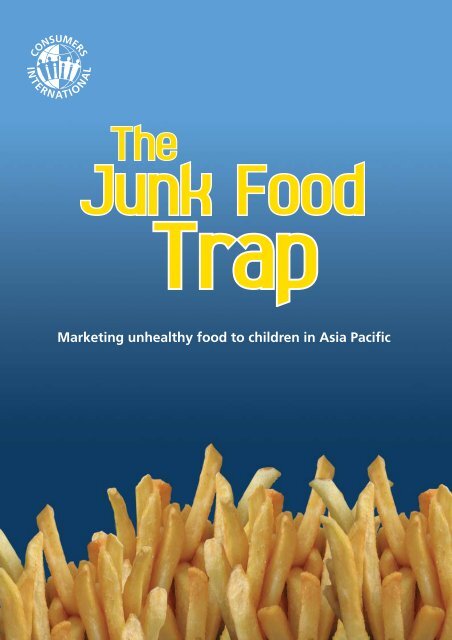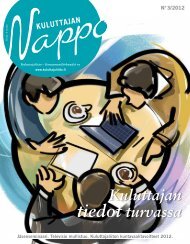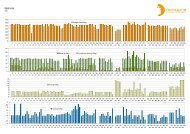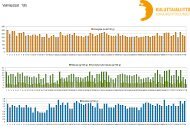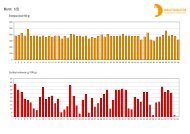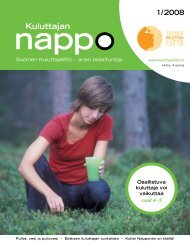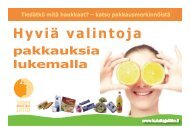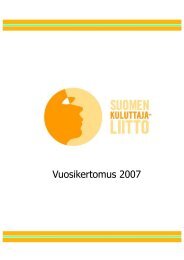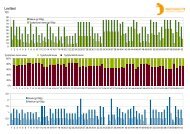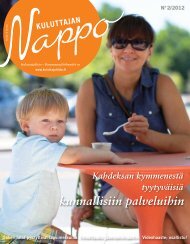Marketing unhealthy food to children in Asia Pacific - Consumers ...
Marketing unhealthy food to children in Asia Pacific - Consumers ...
Marketing unhealthy food to children in Asia Pacific - Consumers ...
- No tags were found...
Create successful ePaper yourself
Turn your PDF publications into a flip-book with our unique Google optimized e-Paper software.
<strong>Market<strong>in</strong>g</strong> <strong>unhealthy</strong> <strong>food</strong> <strong>to</strong> <strong>children</strong> <strong>in</strong> <strong>Asia</strong> <strong>Pacific</strong>
About <strong>Consumers</strong> International (CI)<strong>Consumers</strong> International (CI) is the only <strong>in</strong>dependent global campaign<strong>in</strong>g voice for consumers. With over220 member organisations <strong>in</strong> 115 countries, we are build<strong>in</strong>g a powerful <strong>in</strong>ternational consumer movement<strong>to</strong> help protect and empower consumers everywhere.<strong>Consumers</strong> International is a not-for-profit company limited by guarantee <strong>in</strong> the UK (company number4337856) and a registered charity (number 1122155).For more <strong>in</strong>formation, visit www.consumers<strong>in</strong>ternational.orgThis report was compiled by CI’s Kuala Lumpur Office and is part of Junk Food Generation – the campaign<strong>to</strong> s<strong>to</strong>p the market<strong>in</strong>g of <strong>unhealthy</strong> <strong>food</strong> <strong>to</strong> <strong>children</strong>.For more <strong>in</strong>formation, visit: www.junk<strong>food</strong>generation.orgThe Junk Food Trap<strong>Market<strong>in</strong>g</strong> <strong>unhealthy</strong> <strong>food</strong> <strong>to</strong> <strong>children</strong> <strong>in</strong> <strong>Asia</strong> <strong>Pacific</strong>ISBN 978-0-9560297-0-6Published by <strong>Consumers</strong> International <strong>in</strong> September 2008©<strong>Consumers</strong> International24 Highbury CrescentLondon N5 1RX, UKemail: cons<strong>in</strong>t@cons<strong>in</strong>t.orgwww.consumers<strong>in</strong>ternational.org
<strong>Market<strong>in</strong>g</strong> <strong>unhealthy</strong> <strong>food</strong> <strong>to</strong> <strong>children</strong> <strong>in</strong> <strong>Asia</strong> <strong>Pacific</strong>
CreditsThe report was written by Emily Rob<strong>in</strong>son with the assistance of Arlene De Vera and Johanna Witt at <strong>Consumers</strong>International (CI).Key reviewers of the report <strong>in</strong>cluded Sue Davies, Chief Policy Adviser for Which? (UK), Just<strong>in</strong> Macmullan, IndraniThurais<strong>in</strong>gham, Luke Upchurch and Rosalchen Whitecross at CI.We would like <strong>to</strong> thank the follow<strong>in</strong>g CI members who carried out the research <strong>in</strong> their countries with special mention<strong>to</strong> those who led the work, namely: Patricia Clare of the Consumer Council of Fiji, W<strong>in</strong>nie Cheung of the Hong KongConsumer Council, Nirmala Desikan of the <strong>Consumers</strong> Association of India, Pritee Shah of the Consumer Educationand Research Society (CERC), Pridy Soekar<strong>to</strong> of the Yayasan Lembaga Konsumen Indonesia (YLKI), Cheah Chee-Ho ofthe Federation of Malaysian <strong>Consumers</strong> Associations (FOMCA), Sunil Manandhar of SEWA Nepal, Jennifer del Rosario-Malonzo of the Ibon Foundation, and Sasiwan Par<strong>in</strong>yart of the Foundation for <strong>Consumers</strong>.Design and typesett<strong>in</strong>g: Andrea Carter
ContentsExecutive summary ____________________________________________7Call for action__________________________________________________9Introduction - The <strong>food</strong> trap__________________________________10Evidence for action ____________________________________________13Key f<strong>in</strong>d<strong>in</strong>gs from this research ______________________________13What we have discovered __________________________________14Coca-Cola ______________________________________________14Kellogg’s ______________________________________________16KFC (Yum brands) ______________________________________17McDonald’s ____________________________________________19Nestlé __________________________________________________21PepsiCo ________________________________________________23Overview of government policies ______________________________25Fiji ____________________________________________________25Hong Kong ____________________________________________25India __________________________________________________25Indonesia ______________________________________________26Malaysia________________________________________________26Nepal __________________________________________________27Philipp<strong>in</strong>es______________________________________________27Thailand________________________________________________27Conclusions and recommendations____________________________28Appendix: About the report____________________________________30Our research ______________________________________________30Research methodology______________________________________30Endnotes ____________________________________________________32
Executive summaryThe World Health Organization (WHO) estimates that2.3 billion people, almost one third of the globalpopulation, will be overweight by 2015. While everycont<strong>in</strong>ent has <strong>to</strong> face up <strong>to</strong> the health consequences andeconomic repercussions of this preventable catastrophe,<strong>Asia</strong> is arguably fac<strong>in</strong>g the greatest challenge.Overweight and obesity rates are ris<strong>in</strong>g faster <strong>in</strong> SouthEast <strong>Asia</strong> than anywhere else <strong>in</strong> the world. With apredicted 27.5% rise <strong>in</strong> overweight <strong>children</strong> <strong>in</strong> the regionbetween 2005 and 2010 1 , every contribut<strong>in</strong>g fac<strong>to</strong>rneeds <strong>to</strong> be urgently addressed. This report comes at ahighly significant time.While personal responsibility for ma<strong>in</strong>ta<strong>in</strong><strong>in</strong>g a healthyand active lifestyle is important, governments and theconsumer <strong>in</strong>dustries must also be held <strong>to</strong> account for thesignificant role they need <strong>to</strong> play. None more so than <strong>in</strong>their duty <strong>to</strong> young people.As other em<strong>in</strong>ent studies have shown, an overweight orobese child is far more susceptible <strong>to</strong> be obese and sufferfrom related health issues later <strong>in</strong> life. Action now canprevent immense costs <strong>in</strong> the future - for <strong>in</strong>dividuals andsociety as a whole.However, as this study will demonstrate, the pervasivemarket<strong>in</strong>g of <strong>unhealthy</strong> <strong>food</strong> <strong>to</strong> <strong>children</strong> by the world’slead<strong>in</strong>g <strong>food</strong> and soft dr<strong>in</strong>k manufacturers threatens <strong>to</strong>underm<strong>in</strong>e efforts <strong>to</strong> tackle obesity. From highlysophisticated Internet promotions, <strong>to</strong> the direct appeal ofcelebrity and car<strong>to</strong>on character endorsements; globalbrands are <strong>in</strong>fluenc<strong>in</strong>g the <strong>food</strong> preferences of pre-teenand teenage consumers and underm<strong>in</strong><strong>in</strong>g any positivemessages that young people are receiv<strong>in</strong>g about healthylifestyles.As detailed <strong>in</strong> this report, the scale and reach of thismarket<strong>in</strong>g effort is as<strong>to</strong>nish<strong>in</strong>g. In Malaysia, for <strong>in</strong>stance,KFC’s Chicky Club (a promotion <strong>to</strong>ol for the fast <strong>food</strong>cha<strong>in</strong>’s kids meal) is now the biggest kids club <strong>in</strong> thecountry.Equally, the levels of <strong>unhealthy</strong> <strong>in</strong>gredients <strong>in</strong> popularproducts <strong>in</strong> the region should not be underestimated.Accord<strong>in</strong>g <strong>to</strong> the standard used <strong>in</strong> this report, sugar levelsare considered <strong>to</strong> be high if there is 15g per 100g, yet <strong>in</strong>some countries we found Kellogg’s Frostie’s thatconta<strong>in</strong>ed over 40g per 100g. Nestlé’s MILO Energy Barconta<strong>in</strong>s over 25g of saturated fat per 100g, yet anyth<strong>in</strong>gover 5g is considered <strong>to</strong> be a high level.This report shows that, <strong>to</strong> date, the response fromgovernments and companies <strong>in</strong> this region falls far shor<strong>to</strong>f what many believe is needed. Malaysia and Thailandwere found <strong>to</strong> have the strongest regulation <strong>in</strong> theregion, however there are still plenty of worry<strong>in</strong>gexamples of market<strong>in</strong>g <strong>to</strong> be found <strong>in</strong> these countries.Other countries have even further <strong>to</strong> go, with a completeabsence of on-package nutritional <strong>in</strong>formation <strong>in</strong> India,<strong>to</strong> near non-existent laws <strong>in</strong> Nepal.This problem, and the fight aga<strong>in</strong>st it, is a global one.<strong>Consumers</strong> International (CI), our national memberorganisations and our allies <strong>in</strong> the health sec<strong>to</strong>r havebeen lead<strong>in</strong>g the call for a global ban on the market<strong>in</strong>gof <strong>unhealthy</strong> <strong>food</strong> <strong>to</strong> <strong>children</strong> through the WHO. Whilesome global <strong>food</strong> and soft dr<strong>in</strong>k companies have madelimited national, regional and <strong>in</strong>ternational ‘pledges’ <strong>to</strong>curtail their market<strong>in</strong>g, many are half-hearted,<strong>in</strong>consistent efforts <strong>to</strong> deflect the real commitmentsneeded globally, across the entire sec<strong>to</strong>r.It is time for governments and <strong>in</strong>dustry <strong>to</strong> accept theargument that a global standard for the regulation of<strong>food</strong> market<strong>in</strong>g <strong>to</strong> <strong>children</strong> would give companies clarityand consistency, as well as the best possible <strong>in</strong>centive <strong>to</strong>develop healthy products for <strong>children</strong>.Executive summary7
We believe that the substantial body of evidencecompiled for this report shows the need for a globalframework for restrict<strong>in</strong>g the market<strong>in</strong>g of <strong>unhealthy</strong><strong>food</strong> and dr<strong>in</strong>k <strong>to</strong> <strong>children</strong> and ensur<strong>in</strong>g the promotion ofhealthier choices. Only then can the positive actionsstart<strong>in</strong>g <strong>to</strong> be made by companies and governments <strong>in</strong>the rich world be developed and implemented <strong>in</strong> otherregions that are just as susceptible <strong>to</strong> the mount<strong>in</strong>gthreat of obesity.8 The Junk Food Trap
Call for actionIn March 2008, CI and the International Obesity Taskforce(IOTF) launched Recommendations for an InternationalCode on <strong>Market<strong>in</strong>g</strong> of Foods and Non-AlcoholicBeverages <strong>to</strong> Children 2 .There is a wide disparity between countries <strong>in</strong> theirapproach <strong>to</strong> the market<strong>in</strong>g of <strong>food</strong> <strong>to</strong> <strong>children</strong>. Somehave limited restrictions on advertis<strong>in</strong>g <strong>unhealthy</strong> <strong>food</strong> <strong>to</strong><strong>children</strong>, whilst others have no statu<strong>to</strong>ry protection onany form of advertis<strong>in</strong>g at all. The <strong>food</strong> and dr<strong>in</strong>k<strong>in</strong>dustries’ own codes also vary <strong>in</strong> terms of the countriescovered, the def<strong>in</strong>ition of a child and the types ofmarket<strong>in</strong>g <strong>in</strong>cluded.CI is campaign<strong>in</strong>g for a WHO Code, which will addressthis problem by agree<strong>in</strong>g on <strong>in</strong>ternational standards <strong>to</strong> beimplemented by national governments and <strong>food</strong>companies.The CI/IOTF Code targets the market<strong>in</strong>g of energy dense,nutrient poor <strong>food</strong>s that are high <strong>in</strong> fat, sugar and salt <strong>to</strong><strong>children</strong> up <strong>to</strong> 16 years old. Its demands <strong>in</strong>clude:• A ban on radio or TV adverts promot<strong>in</strong>g <strong>unhealthy</strong><strong>food</strong> between 06.00 and 21.00.• No market<strong>in</strong>g of <strong>unhealthy</strong> <strong>food</strong> <strong>to</strong> <strong>children</strong> us<strong>in</strong>g newmedia (such as websites, social network<strong>in</strong>g sites andtext messag<strong>in</strong>g).• No promotion of <strong>unhealthy</strong> <strong>food</strong> <strong>in</strong> schools.• No <strong>in</strong>clusion of free gifts, <strong>to</strong>ys or collectible items,which appeal <strong>to</strong> <strong>children</strong> <strong>to</strong> promote <strong>unhealthy</strong> <strong>food</strong>s.• No use of celebrities, car<strong>to</strong>on characters, competitionsor free gifts <strong>to</strong> market <strong>unhealthy</strong> <strong>food</strong>.<strong>Consumers</strong> International and the InternationalObesity Task Force released their recommendationsfor an <strong>in</strong>ternational code <strong>in</strong> March 2008You can download a copy of the Code and sign up <strong>in</strong>support at www.junk<strong>food</strong>generation.org.Call for action9
INTRODUCTIONThe <strong>food</strong> trapThe obesity pandemicOverweight and obesity <strong>in</strong> <strong>children</strong> is not a phenomenaconf<strong>in</strong>ed <strong>to</strong> developed nations such as the US, UK andAustralia. The numbers of overweight and obese adultsand <strong>children</strong> are ris<strong>in</strong>g quickly <strong>in</strong> <strong>Asia</strong> <strong>Pacific</strong> and many ofthese develop<strong>in</strong>g countries are ill equipped <strong>to</strong> deal withthe burden of diet-related diseases.For some time, the primary problem for low and middle<strong>in</strong>comecountries has been one of under-nutrition andthe struggle for people <strong>to</strong> eat regular and nutritiousmeals. Obesity was thought of as an issue only for richcountries. Now develop<strong>in</strong>g countries, especially thosewith ris<strong>in</strong>g <strong>in</strong>comes and a grow<strong>in</strong>g middle class <strong>in</strong> urbanareas, are fac<strong>in</strong>g the “double burden” of disease. Undernutritionrema<strong>in</strong>s a challenge, but it exists alongsidegrow<strong>in</strong>g obesity levels.Accord<strong>in</strong>g <strong>to</strong> the WHO, heart disease and stroke arealready the world’s number one cause of death and it isprojected that deaths from diabetes will <strong>in</strong>crease by morethan 50% <strong>in</strong> the next 10 years 3 . The WHO has estimatedthat noncommunicable diseases cause around 60% ofdeaths a year and the majority of these deaths occur <strong>in</strong>low and middle-<strong>in</strong>come countries 4 .Unhealthy diets are one of the major risk fac<strong>to</strong>rs fordevelop<strong>in</strong>g these diseases. Each year at least 2.6 millionpeople die as a result of be<strong>in</strong>g overweight or obese.If a child is obese, he or she is much more likely <strong>to</strong> sufferdisability, illness and premature death as an adult.Experts estimate that 1 <strong>in</strong> 10 school age <strong>children</strong> arecl<strong>in</strong>ically overweight or obese, which is a <strong>to</strong>tal of 155million around the world. A further 22 million <strong>children</strong>under 5 years old are overweight 5 .Overweight <strong>in</strong> <strong>Asia</strong> 2005 and 2010Percentage of population706050403020overweight 2005 menoverweight 2010 menoverweight 2005 womenoverweight 2010 women100India Malaysia Philipp<strong>in</strong>es Vietnam Fiji Ch<strong>in</strong>a Thailand NepalSource: Figures from the WHO Global InfoBase10 The Junk Food Trap
In <strong>Asia</strong> <strong>Pacific</strong>, childhood overweight and obesity ratesare ris<strong>in</strong>g faster than anywhere else <strong>in</strong> the world. In SouthEast <strong>Asia</strong>, between 2005 and 2010 overweight andobesity levels for the school-aged population is expected<strong>to</strong> rise by 27.5%. In Western <strong>Pacific</strong> the figure is 23.5% 6 .The WHO has estimated that noncommunicablediseases cause around 60%of deaths a year and the majorityof these deaths occur <strong>in</strong> low andmiddle-<strong>in</strong>come countriesThe role of <strong>food</strong> market<strong>in</strong>gMany fac<strong>to</strong>rs contribute <strong>to</strong> the risk of develop<strong>in</strong>g obesity.One that has been identified is the way that <strong>unhealthy</strong><strong>food</strong> or products that are energy dense and nutrient poorare marketed <strong>to</strong> <strong>children</strong>.In 2006, the WHO’s Technical Meet<strong>in</strong>g on <strong>Market<strong>in</strong>g</strong> ofFood and Non-Alcoholic Beverages <strong>to</strong> Children concludedthat exposure <strong>to</strong> the promotion of energy dense, nutrientpoor <strong>food</strong>s and beverages can adversely affect <strong>children</strong>’seat<strong>in</strong>g habits. They advised that robust science andresearch shows that there is extensive <strong>food</strong> and beveragepromotion <strong>to</strong> <strong>children</strong>; <strong>children</strong> are aware of, appreciativeof, and engage with this promotion. They also found thatthe market<strong>in</strong>g is overwhelm<strong>in</strong>gly for energy-dense,micronutrient-poor <strong>food</strong>s, which underm<strong>in</strong>esrecommendations for a healthy diet.Professor Gerard Hast<strong>in</strong>gs <strong>in</strong> his review of the evidence 7for the WHO concluded that <strong>children</strong> <strong>in</strong> develop<strong>in</strong>gcountries may be more vulnerable <strong>to</strong> advertis<strong>in</strong>g of<strong>unhealthy</strong> <strong>food</strong> because:• They are less familiar with advertis<strong>in</strong>g <strong>in</strong> general.• They are a key entry po<strong>in</strong>t for companies as they aremore responsive than their parents.• They may associate Western mult<strong>in</strong>ational companybrands with a desirable modern lifestyle.The Global Strategy on Diet, Physical Activity and Health,which was agreed at the World Health Assembly (WHA)<strong>in</strong> May 2004 8 , recognises that <strong>in</strong> order <strong>to</strong> create anenvironment that enables a healthier diet and morephysical activity, a number of fac<strong>to</strong>rs must be tackledsimultaneously. One of the issues identified is <strong>food</strong>market<strong>in</strong>g, which <strong>in</strong>cludes advertis<strong>in</strong>g, sponsorship andpromotion. S<strong>in</strong>ce the adoption of the Global Strategy, theevidence for action on <strong>food</strong> market<strong>in</strong>g <strong>to</strong> <strong>children</strong> hasstrengthened further.Mult<strong>in</strong>ational companies have beenable <strong>to</strong> exploit the lack of controls andregulations on market<strong>in</strong>g andadvertis<strong>in</strong>g <strong>in</strong> develop<strong>in</strong>g countriesOverall the WHO concluded that advertis<strong>in</strong>g has anadverse effect on <strong>children</strong>’s understand<strong>in</strong>g of <strong>food</strong>knowledge, attitude, purchase behaviour andconsumption.Mult<strong>in</strong>ational companies have been able <strong>to</strong> exploit thelack of controls and regulations on market<strong>in</strong>g andadvertis<strong>in</strong>g <strong>in</strong> develop<strong>in</strong>g countries and have been us<strong>in</strong>ga range of techniques <strong>to</strong> promote <strong>food</strong>s, which are high<strong>in</strong> fat, sugar and salt <strong>to</strong> <strong>children</strong>. The CI/IOTF Codedef<strong>in</strong>es ‘<strong>children</strong>’ as younger than 16 years old.Fast <strong>food</strong> <strong>in</strong> FijiThe <strong>food</strong> trap11
When is a product ‘high <strong>in</strong> fat, sugar or salt?We are seek<strong>in</strong>g only <strong>to</strong> restrict the promotion of'<strong>unhealthy</strong>' <strong>food</strong> <strong>to</strong> <strong>children</strong>. This means products thatare high <strong>in</strong> fat, sugar or salt. As a benchmark we usedthe UK’s Food Standards Agency’s criteria for its trafficlabell<strong>in</strong>g scheme <strong>to</strong> def<strong>in</strong>e what is ‘high’.Many of the products <strong>in</strong>cluded <strong>in</strong> this reportconta<strong>in</strong> very high levels of fat, sugar and salt.For example, Fanta made by Coca-Colaconta<strong>in</strong>s 15.2g of sugar per 100ml – that’s10.2 teaspoons of sugar.Junk Food Generation, a CI report published <strong>in</strong> 2004,established through a multi-country survey of parents and<strong>children</strong> 9 that the market<strong>in</strong>g of <strong>unhealthy</strong> <strong>food</strong> <strong>to</strong><strong>children</strong> <strong>in</strong> <strong>Asia</strong> was widespread. The report highlightedthe concern of consumer organisations <strong>in</strong> the region thatthere are <strong>in</strong>sufficient regulations <strong>in</strong> place <strong>to</strong> protectyoung and vulnerable consumers from the effects ofadvertis<strong>in</strong>g.This report considers the current state of market<strong>in</strong>g of<strong>unhealthy</strong> <strong>food</strong> and dr<strong>in</strong>k <strong>to</strong> <strong>children</strong> <strong>in</strong> the region.UK Food Standards Agency Criteria (per 100g/100ml) (Published January 2007)Low Medium HighFat (per 100g) 3g and below Between 3g and 20g Over 20gFat (per 100ml) 1.5g and below Between 1.5g and 10g Over 10gSaturates (per 100g) 1.5g and below Between 1.5g and 5g Over 5gSaturates (per 100ml) 0.75g and below Between 0.75g and 2.5g Over 2.5gTotal sugars (per 100g) 5g and below Between 5g and 15g Over 15gTotal sugars (per 100ml) 2.5g and below Between 2.5g and 7.5g Over 7.5gSalt (per 100g or 100ml) 0.3g and below Between 0.3g and 1.5g Over 1.5g12 The Junk Food Trap
Evidence for actionKey f<strong>in</strong>d<strong>in</strong>gs from this researchOur evidence-based research, carried out with CI memberorganisations <strong>in</strong> <strong>Asia</strong> <strong>Pacific</strong>, looked at market<strong>in</strong>g by thefollow<strong>in</strong>g mult<strong>in</strong>ational <strong>food</strong> and dr<strong>in</strong>k companiesbetween April and June 2008:• Coca-Cola• Kellogg’s• KFC• McDonald’s• Nestlé, and• PepsiCo.We found:• The six companies featured <strong>in</strong> this report offered anumber of globally recognised <strong>food</strong> products <strong>to</strong><strong>children</strong> below 16 years old that are <strong>unhealthy</strong> basedon the UK Food Standards Agency criteria for what ishigh <strong>in</strong> fat, sugar and/or salt.• These same mult<strong>in</strong>ational companies are heavilymarket<strong>in</strong>g their <strong>unhealthy</strong> <strong>food</strong> products <strong>to</strong> <strong>children</strong>below 16 years old.The techniques that these six mult<strong>in</strong>ational companiesused <strong>to</strong> market their products <strong>to</strong> <strong>children</strong> <strong>in</strong>clude some ofthe follow<strong>in</strong>g:• sponsorship of <strong>children</strong>’s sport<strong>in</strong>g activities <strong>in</strong> schools• television advertis<strong>in</strong>g• <strong>in</strong>teractive websites• sports-themed contests and competitions• discounts and money-off vouchers for other products• use of car<strong>to</strong>on characters• on-pack games and promotions• movie tie-<strong>in</strong>s• <strong>children</strong>’s clubs• free <strong>to</strong>ys• <strong>children</strong>’s meals• celebrity endorsements• <strong>children</strong>’s parties• posters• language teach<strong>in</strong>g• sponsorship of <strong>children</strong>’s TV programmes.Particularly concern<strong>in</strong>g techniques highlighted <strong>in</strong> ourresearch <strong>in</strong>clude:• Sports-themed competitions and sponsorship <strong>in</strong>schools – Companies are deliberately associat<strong>in</strong>g theirbrands and <strong>unhealthy</strong> products with sports activities,both <strong>in</strong> terms of sponsor<strong>in</strong>g sports-themedcompetitions where sports-related prizes can be wonand <strong>in</strong> sponsor<strong>in</strong>g schools’ sports events. This can givecontradic<strong>to</strong>ry messages <strong>to</strong> <strong>children</strong> about whatconstitutes healthy lifestyles. ‘Energy’ products add <strong>to</strong>this confusion, such as MILO, which is marketed asprovid<strong>in</strong>g energy plus vitam<strong>in</strong>s and m<strong>in</strong>erals and yet ishigh <strong>in</strong> fat and sugar.• <strong>Market<strong>in</strong>g</strong> <strong>in</strong> schools – Examples were found wheremult<strong>in</strong>ational companies are market<strong>in</strong>g their products<strong>to</strong> <strong>children</strong> <strong>in</strong> schools, either through promotionalgimmicks that offered students the chance <strong>to</strong> w<strong>in</strong>gadgets such as mobile phones or through organisedgames and activities with the special participation ofcompany mascots. These examples <strong>in</strong>volved directpromotion <strong>to</strong> <strong>children</strong> of <strong>unhealthy</strong> products, which arehigh <strong>in</strong> fat, sugar and/or salt.Evidence for action13
• Interactive websites – There is evidence <strong>to</strong> show<strong>in</strong>creas<strong>in</strong>g use of the Internet by mult<strong>in</strong>ationalcompanies <strong>in</strong> <strong>Asia</strong> <strong>Pacific</strong> <strong>to</strong> promote <strong>unhealthy</strong>products. (This is of particular concern because it is anarea where parents often f<strong>in</strong>d it difficult <strong>to</strong> regulatewhat their <strong>children</strong> are view<strong>in</strong>g). These websites areoften related <strong>to</strong> onl<strong>in</strong>e <strong>children</strong>’s clubs. Increasedconsumption is encouraged, for example, throughpromotions or plac<strong>in</strong>g codes on packag<strong>in</strong>g that can beused <strong>to</strong> collect free gifts.• Car<strong>to</strong>ons and celebrities – Companies are us<strong>in</strong>g arange of tried and tested traditional market<strong>in</strong>gtechniques like car<strong>to</strong>on characters (both brand ownedand licensed) and celebrities <strong>to</strong> appeal <strong>to</strong> <strong>children</strong>. In<strong>Asia</strong> <strong>Pacific</strong> companies use national celebrities andcar<strong>to</strong>on characters, as well as global stars or characters.Children <strong>in</strong> poorer countries may be more vulnerable <strong>to</strong>appeals from those characters that suggest a Westernlifestyle.The need for an <strong>in</strong>ternational codeThe evidence conta<strong>in</strong>ed <strong>in</strong> this report shows thatcompanies across the region are us<strong>in</strong>g market<strong>in</strong>gtechniques <strong>to</strong> promote <strong>unhealthy</strong> <strong>food</strong> <strong>to</strong> <strong>children</strong>.However, there is little consistency <strong>in</strong> terms of the<strong>in</strong>formation they provide <strong>to</strong> consumers with companiesprovid<strong>in</strong>g basic nutritional advice <strong>in</strong> some countries, butnot <strong>in</strong> others.Companies are also attract<strong>in</strong>g attention for mak<strong>in</strong>g newcommitments <strong>in</strong> the US and the EU, whilst not evenrespond<strong>in</strong>g <strong>to</strong> enquiries from consumer organisations <strong>in</strong>the <strong>Asia</strong> <strong>Pacific</strong> region.National governments, aware of the growth of obesityrelateddiseases are, <strong>in</strong> some countries, beg<strong>in</strong>n<strong>in</strong>g <strong>to</strong> takeaction. However, <strong>to</strong> date, the responses are <strong>in</strong>adequate.CI believes that the WHO has a responsibility <strong>to</strong> showleadership <strong>in</strong> this area and produce policies that can beeasily and swiftly implemented by national governments,as well as provid<strong>in</strong>g a benchmark for responsible <strong>food</strong><strong>in</strong>dustry practice.What we have discoveredThe six mult<strong>in</strong>ational companies, their policies andmarket<strong>in</strong>g techniques promot<strong>in</strong>g <strong>unhealthy</strong> <strong>food</strong>s<strong>to</strong> kidsCoca-ColaInformation gathered <strong>in</strong> Fiji, Hong Kong, India, Indonesia,Malaysia, Nepal, Philipp<strong>in</strong>es and ThailandWhat’s <strong>in</strong> the products?Classic Coca-Cola is high <strong>in</strong> sugar (between10g and 11g per 100 ml bottle which isequivalent <strong>to</strong> almost 9 teaspoons of sugar).Fanta is even higher <strong>in</strong> sugar (between 11.7gand 15.2g per 100ml bottle.)These results focus on classic Coca-Cola and Fanta, whichare globally recognised brands.Policy on market<strong>in</strong>g <strong>to</strong> <strong>children</strong> and tackl<strong>in</strong>gobesity/nutritionCI members <strong>in</strong> Fiji, Hong Kong, Nepal, Philipp<strong>in</strong>es andThailand did not receive responses <strong>to</strong> requests for<strong>in</strong>formation on policies relat<strong>in</strong>g <strong>to</strong> market<strong>in</strong>g <strong>to</strong> <strong>children</strong>and obesity from Coca-Cola.GlobalIn May 2008, the International Council of BeveragesAssociations announced a set of Guidel<strong>in</strong>es on <strong>Market<strong>in</strong>g</strong><strong>to</strong> Children, which Coca-Cola (as a member) have signedup <strong>to</strong> and endorsed. This means that with the exceptionof water, fruit juices and dairy-based dr<strong>in</strong>ks, Coca-Colawill not advertise its beverages where <strong>children</strong> under 12years old make up over 50% of the audience <strong>in</strong> media<strong>in</strong>clud<strong>in</strong>g TV, radio, pr<strong>in</strong>t or digital media or c<strong>in</strong>ema(<strong>in</strong>clud<strong>in</strong>g product placement). These are globalguidel<strong>in</strong>es and cover all countries where Coca-Cola ismarketed. Other market<strong>in</strong>g practices <strong>in</strong>volv<strong>in</strong>g <strong>children</strong>under 12, such as the use of licensed characters,sponsorship and communications <strong>in</strong> schools will bereviewed by the end of 2009.ThailandAlthough this announcement was not provided directly <strong>to</strong>the CI member <strong>in</strong> Thailand, <strong>in</strong> May 2008, Coca-Cola,Kellogg’s, Nestlé and PepsiCo were among a group ofcompanies <strong>to</strong> announce a “Thai pledge” 10 . Under this ac<strong>to</strong>f self-regulation, these companies will s<strong>to</strong>padvertisements of <strong>food</strong> and beverages <strong>to</strong> <strong>children</strong> under12 years old by the end of 2008. They would also s<strong>to</strong>pcommercial activities <strong>in</strong> schools unless <strong>in</strong>vited for thepurpose of dissem<strong>in</strong>at<strong>in</strong>g educational <strong>in</strong>formation, whichleaves them a w<strong>in</strong>dow of opportunity <strong>to</strong> cont<strong>in</strong>uemarket<strong>in</strong>g their products. The pledge was not wellpublicised <strong>in</strong> the local press.14 The Junk Food Trap
IndiaCoca-Cola <strong>in</strong> India <strong>in</strong>formed CERC (Consumer Educationand Research Society) that the company “markets itsproducts responsibly and does not market soft dr<strong>in</strong>ks <strong>to</strong><strong>children</strong> under the age of 12.” They added that for morethan 50 years they have had a policy not <strong>to</strong> advertise“sparkl<strong>in</strong>g” soft dr<strong>in</strong>ks on TV programmes that target<strong>children</strong> under 12. At the same time, they <strong>in</strong>dicated <strong>in</strong>their response that they respect classrooms as a“commercial-free zone” and their support <strong>to</strong> schools islimited <strong>to</strong> activities that promote physical activity,academic achievement and education about balancednutrition and healthy habits.In terms of obesity, Coca-Cola po<strong>in</strong>ted out that “No <strong>food</strong>or beverage is responsible for obesity. Obesity is acomplex problem that has no easy answers and we allneed <strong>to</strong> work <strong>to</strong>gether <strong>to</strong> f<strong>in</strong>d workable solutions <strong>to</strong> thiscomplex problem.” As part of their role <strong>in</strong> address<strong>in</strong>gobesity they listed the follow<strong>in</strong>g as their concrete actions:• Provid<strong>in</strong>g variety <strong>in</strong> the broad portfolio of our beverageproducts.• Support<strong>in</strong>g healthy and active lifestyles for all people,especially our young people through youthdevelopment and education programmes.• Respect<strong>in</strong>g the rights of parents, teachers and schoolofficials <strong>to</strong> make choices for <strong>children</strong>.• Work<strong>in</strong>g with representatives of government, NGOsand the public health community <strong>to</strong> ensure that thediscussion about obesity rema<strong>in</strong>s grounded <strong>in</strong> fact andscientific evidence.• Cont<strong>in</strong>u<strong>in</strong>g <strong>to</strong> work <strong>to</strong>gether with all stakeholders.MalaysiaF&N Coca-Cola <strong>in</strong> Malaysia responded <strong>to</strong> FOMCA, the CImember <strong>in</strong> Malaysia, say<strong>in</strong>g that <strong>in</strong> general Coca-Coladoes not specifically aim products at <strong>children</strong> althoughthey recognise that <strong>children</strong> do consume their productsunder parental supervision. F&N stands for Fraser &Neave, the last names of the bus<strong>in</strong>ess partners thatestablished the company, which holds the Coca-Colabottl<strong>in</strong>g franchise for S<strong>in</strong>gapore and Malaysia.In terms of market<strong>in</strong>g <strong>to</strong> <strong>children</strong>, F&N Coca-Colaprovides nutritional <strong>in</strong>formation on packag<strong>in</strong>g andrespects school policies on beverages. It has an ActiveLifestyle programme with which they work through100Plus, an iso<strong>to</strong>nic dr<strong>in</strong>k, with the M<strong>in</strong>istry of Education<strong>to</strong> promote sport <strong>in</strong> schools.<strong>Market<strong>in</strong>g</strong> tactics we discoveredSponsorship of <strong>children</strong>’s sports activities<strong>in</strong> schoolsCoca-Cola has been the ma<strong>in</strong> sponsor of the Coke Games<strong>in</strong> Fiji for the last 25 years. This is an athletics competitionfor 120 secondary schools <strong>in</strong> Fiji. There is, we say, widespreadbrand<strong>in</strong>g of the event us<strong>in</strong>g the high sugar ‘classic’Coca-Cola brand. This can give <strong>children</strong> contradic<strong>to</strong>rymessages about what constitutes a healthy lifestyle.Television advertis<strong>in</strong>gCoca-Cola regularly advertises on ma<strong>in</strong>stream televisionmedia channels <strong>in</strong> Hong Kong. Dur<strong>in</strong>g the moni<strong>to</strong>r<strong>in</strong>gperiod, Coca-Cola adverts were found for 2008 Olympicsrelated<strong>food</strong> product promotions at times <strong>children</strong> arewatch<strong>in</strong>g TV, such as Sunday early afternoons.Coca-Cola uses celebrities, such as the Bollywood ac<strong>to</strong>rHrithik Roshan, <strong>in</strong> TV advertis<strong>in</strong>g <strong>in</strong> India and Nepal.Hrithik Roshan is a young male star who is very popularwith teenagers. In the commercial shown <strong>in</strong> Nepal,Hrithik was featured say<strong>in</strong>g “Party starts and ends withCoke!” Coke promotions and advertisements <strong>in</strong> Nepalare mostly developed <strong>in</strong> India.In Thailand, Coca-Cola uses car<strong>to</strong>on characters <strong>in</strong> TVadvertis<strong>in</strong>g that appeals <strong>to</strong> <strong>children</strong>. In the latestcommercial for Fanta, a young female car<strong>to</strong>on characterwas shown as a cool and able musician because shedr<strong>in</strong>ks Fanta. In contrast, young male car<strong>to</strong>on charactersstruggled <strong>to</strong> play music <strong>in</strong> spite of try<strong>in</strong>g so hard;apparently because they were not dr<strong>in</strong>k<strong>in</strong>g Fanta.With regards <strong>to</strong> obesity, F&N Coca-Cola “believes <strong>in</strong>offer<strong>in</strong>g choices and we provide a wide variety ofbeverages (<strong>in</strong>clud<strong>in</strong>g many low calorie and no-calorieoptions) as well as portion sizes <strong>to</strong> meet consumers needsfor fun, refreshment, nutrition and hydration for alllifestyles”.Fanta TV advert <strong>in</strong> ThailandEvidence for action15
Interactive websitesCoca-Cola has an <strong>in</strong>teractive website, www.iCoke.hk,with a membership programme, Internet games, a blog,a chat room and forums. Advertis<strong>in</strong>g <strong>in</strong>formation andproduct logos are embedded <strong>in</strong> the website.Kellogg’sInformation gathered <strong>in</strong> Hong Kong, India, and ThailandWhat’s <strong>in</strong> the products?Many Kellogg’s cereals marketed <strong>to</strong> <strong>children</strong>are very high <strong>in</strong> sugar, <strong>in</strong>clud<strong>in</strong>g Coco Pops(38.7g per 100g) and Frosties (sugar levelsvaried between 28.3g and 41.7g per 100g).Web shot of Coca-Cola Hong Kong websiteSports-themed competitionsIn Malaysia, Coca-Cola and Sprite brands were promot<strong>in</strong>ga lucky draw offer<strong>in</strong>g a grand prize of two tickets <strong>to</strong>watch the EURO 2008 f<strong>in</strong>al <strong>in</strong> Europe and other prizes<strong>in</strong>clud<strong>in</strong>g a 32-<strong>in</strong>ch LCD TV, sports bags and footballshirts. Children aged 12 years old and above were eligible<strong>to</strong> enter the competition.Discounts and money off vouchers for otherproductsIn Indonesia, Coca-Cola has been runn<strong>in</strong>g a promotionwhere if you buy a 1.5 litre bottle of high sugar Fanta youwill receive a voucher offer<strong>in</strong>g a discount at GramediaBooks<strong>to</strong>re. Gramedia is a newly-refurbished books<strong>to</strong>reclaim<strong>in</strong>g <strong>to</strong> be the largest books<strong>to</strong>re <strong>in</strong> South East <strong>Asia</strong>and showcases a wide collection of <strong>children</strong>’s books.In India, the amount of sugar conta<strong>in</strong>ed <strong>in</strong>packets of Fruit Loops, Choco Toffee andFrosties is not listed on the packag<strong>in</strong>g.Policy on market<strong>in</strong>g <strong>to</strong> <strong>children</strong> and tackl<strong>in</strong>gobesity/nutritionResponses <strong>to</strong> requests for <strong>in</strong>formation on policies relat<strong>in</strong>g<strong>to</strong> market<strong>in</strong>g <strong>to</strong> <strong>children</strong> and obesity and nutrition were notreceived from Kellogg’s by CI members <strong>in</strong> India or Thailand.GlobalIn June 2007, Kellogg’s announced changes <strong>to</strong> itsWorldwide <strong>Market<strong>in</strong>g</strong> Guidel<strong>in</strong>es. This now means <strong>food</strong>sthat do not meet its own Nutrient Criteria will not beadvertised on TV, radio or third party websites where50% or more of the audience are <strong>children</strong> under 12 yearsold. It will also not use third party licensed characters,product placements or schools sett<strong>in</strong>gs <strong>to</strong> advertise theseproducts <strong>to</strong> <strong>children</strong> under 12 years old. It also states thatno products are marketed <strong>to</strong> <strong>children</strong> under 6 years old.Hong KongKellogg’s provided a lengthy response cover<strong>in</strong>g obesity,nutrition and the market<strong>in</strong>g of <strong>food</strong> <strong>to</strong> <strong>children</strong> <strong>to</strong> theHong Kong Consumer Council. This reiterated<strong>in</strong>formation conta<strong>in</strong>ed <strong>in</strong> the global announcement <strong>in</strong>June 2007 described above.Fanta voucher <strong>in</strong> IndonesiaPostersCoca-Cola uses this poster advertisement for Fanta <strong>in</strong>Thailand. The poster features a teenager on a skateboardso that it would appeal <strong>to</strong> <strong>children</strong> under 16 years old.Poster of Fanta advert <strong>in</strong> Indonesia<strong>Market<strong>in</strong>g</strong> tactics we discoveredUse of car<strong>to</strong>on charactersKellogg’s repeatedly use their own brand car<strong>to</strong>oncharacters such as Tony the Tiger and Coco the Monkey<strong>to</strong> market their high sugar products <strong>to</strong> <strong>children</strong>. This wasa common feature <strong>in</strong> all the CI member countries thatprovided examples of market<strong>in</strong>g <strong>to</strong> <strong>children</strong> by Kellogg’s.In Thailand, Kellogg’s use both own brand and licensedcar<strong>to</strong>on characters, such as Garfield <strong>to</strong> promote breakfastcereals.16 The Junk Food Trap
Policy on market<strong>in</strong>g <strong>to</strong> <strong>children</strong> and tackl<strong>in</strong>gobesity/nutritionMalaysiaKFC Hold<strong>in</strong>gs Malaysia “believe(s) that healthy eat<strong>in</strong>g is alifestyle choice and that any <strong>food</strong> properly consumed <strong>in</strong>moderation can be a part of a balanced diet. We do notand never have advocated uncontrolled consumption of<strong>food</strong>. We have also taken steps <strong>to</strong> help our cus<strong>to</strong>mersmake educated choices when it comes <strong>to</strong> choos<strong>in</strong>g theirmeals, <strong>in</strong>clud<strong>in</strong>g help<strong>in</strong>g them become aware about theimportance of a balanced diet and good nutrition.”As for policies on market<strong>in</strong>g of <strong>food</strong> <strong>to</strong> <strong>children</strong>, KFCstates that, “we comply (with) all the guidel<strong>in</strong>es set bythe M<strong>in</strong>istry of Health <strong>in</strong> collaboration with theAssociation of Accredited Advertis<strong>in</strong>g Agents Malaysiaperta<strong>in</strong><strong>in</strong>g <strong>to</strong> advertisements for <strong>children</strong>”. Approved <strong>in</strong>June 2007, the guidel<strong>in</strong>es ban the sponsorship by fast<strong>food</strong> <strong>in</strong>dustries of <strong>children</strong>’s TV programmes and fast<strong>food</strong> advertisements dur<strong>in</strong>g <strong>children</strong>’s TV programmes.With respect <strong>to</strong> nutritional labell<strong>in</strong>g, KFC has developednutritional content fact sheets of their products asrequired by the recent national fast <strong>food</strong> regulations.Responses <strong>to</strong> requests for <strong>in</strong>formation on policies relat<strong>in</strong>g<strong>to</strong> market<strong>in</strong>g <strong>to</strong> <strong>children</strong> and obesity and nutrition were notreceived from KFC for the CI member <strong>in</strong> the Philipp<strong>in</strong>es.KFC Chicky Club kids meal and giveaways <strong>in</strong> MalaysiaChildren’s meal with free <strong>to</strong>ys and movie tie-<strong>in</strong>sIn Malaysia, each of KFC’s Chicky Meals comes with a <strong>to</strong>ywith the type and design of the <strong>to</strong>ys vary<strong>in</strong>g <strong>in</strong>accordance <strong>to</strong> KFC’s current market<strong>in</strong>g tie-<strong>in</strong>s withmovies, car<strong>to</strong>on characters, or popular <strong>to</strong>y figures. The X-Meal for teens often comes with collectible merchandise,such as key cha<strong>in</strong>s.In the Philipp<strong>in</strong>es KFC has used film tie-<strong>in</strong>s such asSuperman, Spiderman, and Scooby Doo <strong>to</strong> market itsmeals. These film icons appear on packag<strong>in</strong>g, tumblers,or as <strong>to</strong>ys.KFC also offers <strong>to</strong>ys such as Wall Smasher, Floor Racer,Image Sp<strong>in</strong>ner, and Beam Bender; and <strong>in</strong>novativeproducts such as Colonel Sanders Figur<strong>in</strong>e and Car<strong>to</strong>onNetwork CDs.<strong>Market<strong>in</strong>g</strong> tactics we discoveredChildren’s clubsThe Chicky Club created by KFC is the largest kids’ club<strong>in</strong> Malaysia (acknowledged by the Malaysian Book ofRecords). Chicky Club members are entitled <strong>to</strong> specialoffers from KFC, such as meal discounts, specialcollectible <strong>to</strong>ys/merchandise, and birthday eventcelebrations. Members also have access <strong>to</strong> a variety ofdiscounts at KFC’s market<strong>in</strong>g partners, which <strong>in</strong>clude <strong>to</strong>ys<strong>to</strong>res, <strong>children</strong>’s apparel, theme parks, music classes, andc<strong>in</strong>emas. Membership of the club is open <strong>to</strong> <strong>children</strong> up<strong>to</strong> 12 years old.Chicky Club ‘Speed Racer’ movie giveaways <strong>in</strong> MalaysiaInteractive websitesKFC’s website <strong>in</strong> Malaysia www.kfc.com.my has acolourful section exclusively for <strong>children</strong>. Featur<strong>in</strong>g thema<strong>in</strong> character Chicky and his friends (Chippy, Adora,Slyde, Wanda, and Ace), the website offers a variety ofonl<strong>in</strong>e activities. Visi<strong>to</strong>rs <strong>to</strong> the website can play onl<strong>in</strong>egames and view updates on KFC’s latest offers andprogrammes for kids.KFC Chicky Club promotion <strong>in</strong> MalaysiaChicky Club onl<strong>in</strong>e game from Malaysia18 The Junk Food Trap
In school market<strong>in</strong>gKFC <strong>in</strong> Malaysia also has a programme called “Chicky goes<strong>to</strong> School”, whereby <strong>children</strong> and teachers are encouraged<strong>to</strong> <strong>in</strong>vite Chicky and his friends over <strong>to</strong> their schools <strong>to</strong>organise games and activities. KFC also organises theChicky Carnival, a theme-based annual event featur<strong>in</strong>gcontests, musical shows, games, and rides.TV advertis<strong>in</strong>gIn the Philipp<strong>in</strong>es, KFC’s TV commercials focus heavily onfamily images of people eat<strong>in</strong>g <strong>to</strong>gether <strong>to</strong> advertise KFCmeals <strong>in</strong>clud<strong>in</strong>g the Bucket Meal, Fully Loaded Meal andthe Kid’s Meal. Meanwhile, teenagers <strong>in</strong> the advertsendorse Funshots and Snackables.McDonald's Happy Meal <strong>in</strong> MalaysiaMcDonald’s Happy Meal menu from Hong KongKFC Chicky goes <strong>to</strong> school onl<strong>in</strong>e promotion <strong>in</strong> MalaysiaMcDonald’sInformation gathered <strong>in</strong> Fiji, Hong Kong, India, Malaysia,Philipp<strong>in</strong>es and ThailandWhat’s <strong>in</strong> the products?The McDonald’s Happy Meal for <strong>children</strong> has avariety of comb<strong>in</strong>ations, which vary fromcountry <strong>to</strong> country. However, <strong>in</strong> most countries,this consists of a burger, fries and a soft dr<strong>in</strong>k.In Hong Kong, a Happy Meal can comb<strong>in</strong>eSausage McMuff<strong>in</strong> (19g of fat), Hash Browns (9gof fat) and a small soft dr<strong>in</strong>k, such as Coke. The<strong>in</strong>formation on saturated fat is not available <strong>in</strong>Hong Kong. In Malaysia, Happy Meals come witha small portion of fries (10.3g of fat and 0.3g ofsalt).It was not clear from the <strong>in</strong>formation providedwhether the measurements were per 100g orper portion.In some countries, such as the Philipp<strong>in</strong>es, nonutritional <strong>in</strong>formation was provided <strong>in</strong> therestaurant or on request.Policy on market<strong>in</strong>g <strong>to</strong> <strong>children</strong> and tackl<strong>in</strong>gobesity/nutritionCI members <strong>in</strong> Fiji, Philipp<strong>in</strong>es, and India did not receiveresponses <strong>to</strong> requests for <strong>in</strong>formation on policies relat<strong>in</strong>g<strong>to</strong> market<strong>in</strong>g <strong>to</strong> <strong>children</strong> from McDonald’s.MalaysiaMcDonald’s is “committed <strong>to</strong> be<strong>in</strong>g part of the solutionby re<strong>in</strong>forc<strong>in</strong>g the importance of energy balance – the<strong>food</strong> you eat and the activity you do. McDonald’sBalance, Active Lifestyles programme is built on threestrategic pillars – <strong>in</strong>creas<strong>in</strong>g menu choice, promot<strong>in</strong>gphysical activity and cont<strong>in</strong>u<strong>in</strong>g <strong>to</strong> provide accessiblenutrition <strong>in</strong>formation.”On nutrition they ”offer a wide variety of high qualityfreshly prepared <strong>food</strong> choices, a varied menu and rangeof serv<strong>in</strong>g sizes <strong>to</strong> provide items that fit <strong>in</strong><strong>to</strong> a balanceddiet. We also offer a range of meal comb<strong>in</strong>ations that fallwith<strong>in</strong> recommended guidel<strong>in</strong>es for calories, fat andother nutrients.”McDonald’s have <strong>in</strong>dicated <strong>in</strong> their response <strong>to</strong> FOMCAthat start<strong>in</strong>g June 2008 product packag<strong>in</strong>g will featurenutritional <strong>in</strong>formation. FOMCA reported thatMcDonald’s is now provid<strong>in</strong>g nutritional <strong>in</strong>formation ontheir paper-tray mats <strong>to</strong> cover fat, sugar and salt, andbooklets list<strong>in</strong>g the nutritional <strong>in</strong>formation of all theirEvidence for action19
products, are also available <strong>in</strong> their outlets. McDonald’sMalaysia also shared that they have not advertised on TV<strong>to</strong> <strong>children</strong> s<strong>in</strong>ce July 2007.Hong KongMcDonald’s has adopted the follow<strong>in</strong>g pr<strong>in</strong>ciples <strong>to</strong>:• Communicate <strong>to</strong> <strong>children</strong> balanced <strong>food</strong> choices thatfit with<strong>in</strong> a child’s nutritional needs.• Use licensed characters and properties <strong>to</strong> encourageactivity and balanced <strong>food</strong> choices for <strong>children</strong> <strong>to</strong> make<strong>food</strong>, such as fruit and vegetables, fun <strong>to</strong> eat.• Promote <strong>to</strong> <strong>children</strong> positive messages that supporttheir well-be<strong>in</strong>g, body, m<strong>in</strong>d and spirit.• Provide the nutritional <strong>in</strong>formation of <strong>food</strong> <strong>to</strong> helpparents and families make <strong>in</strong>formed <strong>food</strong> choices.More specific <strong>in</strong>formation from McDonald’s <strong>in</strong>cludeschanges <strong>to</strong> the Happy Meal menus, such as add<strong>in</strong>g thefollow<strong>in</strong>g items <strong>to</strong> the menu, <strong>in</strong>clud<strong>in</strong>g Qoo White GrapeJuice Dr<strong>in</strong>k, Qoo Soya Milk, Hi-Calcium Mango FruitYogurt and Hi-Calcium Low fat Milk.Leaflets conta<strong>in</strong><strong>in</strong>g product nutritional <strong>in</strong>formation areavailable at McDonald’s s<strong>to</strong>res. The <strong>in</strong>formation is alsopr<strong>in</strong>ted on the company’s tray mat and posted on thecompany website. However, some of this <strong>in</strong>formationsuch as the tray mat is only available after the purchasehas been made.<strong>Market<strong>in</strong>g</strong> tactics we discoveredChildren’s meal with free <strong>to</strong>yIn all countries that provided <strong>in</strong>formation on McDonald’s,the “Happy Meal” menu offers <strong>food</strong> aimed specifically at<strong>children</strong> and a free collectible <strong>to</strong>y. It <strong>in</strong>cludes less healthyoptions. There is usually a number of different <strong>to</strong>ys <strong>to</strong>collect with<strong>in</strong> a set range which lasts for a certa<strong>in</strong> periodof time before chang<strong>in</strong>g <strong>to</strong> a different range. Dur<strong>in</strong>g theresearch period, Happy Meals <strong>in</strong>cluded Power Puff Girls,Naru<strong>to</strong> and Angel Blue collectible <strong>to</strong>ys. Created byJapanese designer Narumiya, the Angel Blue l<strong>in</strong>e ofclothes features car<strong>to</strong>on-like characters <strong>in</strong> pastel coloursthat are popular with young girls and teenagers. Naru<strong>to</strong>is a Japanese manga series with an anime adaptation.The ma<strong>in</strong> character, Naru<strong>to</strong> Uzumaki, is a hyperactive,unpredictable, adolescent n<strong>in</strong>ja who constantly searchesfor recognition and aspires <strong>to</strong> become a Hokage, then<strong>in</strong>ja <strong>in</strong> his village that is acknowledged as the leader andthe strongest of all.Children’s clubsIn Malaysia, McDonald’s mascot, Ronald McDonald has a<strong>children</strong>’s club called the “Ronald McDonald Kids’ Club”.By jo<strong>in</strong><strong>in</strong>g the club, members are eligible for discountsand privileges from McDonald’s and their partners, whichrange from theme parks <strong>to</strong> kids’ gym memberships.Members can also participate <strong>in</strong> fun activities and eventsorganised by McDonald’s plus a free quarterly newslettercalled “Red Shoe News”. In its latest promotion for theKung Fu Panda movie, McDonald’s is offer<strong>in</strong>g its clubmembers a chance <strong>to</strong> redeem two free movie tickets bycomplet<strong>in</strong>g a redemption form complete with a HappyMeal receipt.McDonald's "Kung Fu Panda" movie tie-<strong>in</strong>s <strong>in</strong> MalaysiaCelebrity endorsementsMcDonald’s have used popular celebrities <strong>in</strong> thePhilipp<strong>in</strong>es, like Sharon Cuneta and her daughters plusworld-box<strong>in</strong>g champion Manny Pacquiao and his twosons <strong>to</strong> endorse some of their products. Also Kris Aqu<strong>in</strong>o,presenter of the popular TV show “Deal or No Deal”, dida commercial spoof of the show called “meal or nomeal”. All these celebrities are well known and idolisedas role models for <strong>children</strong>.Another McDonald’s celebrity endorsement features apopular young actress Angel Locs<strong>in</strong>, who endorsedMcDonald’s summer ice cream treats <strong>in</strong> the “SummerColours of Love” promotion. She is particularly popularwith <strong>children</strong> after starr<strong>in</strong>g <strong>in</strong> a number of super heroroles such as Darna (Wonderwoman) and Mulaw<strong>in</strong>(W<strong>in</strong>ged Humanoids).TV advertis<strong>in</strong>gIn Hong Kong, McDonald’s advertise their Happy Mealson ma<strong>in</strong>stream television channels dur<strong>in</strong>g weekdayafternoons (after school hours) and weekend morn<strong>in</strong>gsand afternoons. Usually the advertisements are about<strong>children</strong> play<strong>in</strong>g with the Happy Meal <strong>to</strong>ys, particularlythe Naru<strong>to</strong> and Angel Blue collectibles.McDonald’s was also found <strong>to</strong> advertise its products on<strong>children</strong>’s channels <strong>in</strong> India and Thailand.20 The Junk Food Trap
Sports-themed competitionsIn conjunction with the 2008 Beij<strong>in</strong>g Olympics,McDonald’s is currently runn<strong>in</strong>g the “McDonald’sChampion Kids Challenge” for <strong>children</strong> below the age of14 <strong>in</strong> many parts of <strong>Asia</strong>, such as <strong>in</strong> Thailand and <strong>in</strong>Malaysia. Contestants compete <strong>in</strong> the challenge andthree w<strong>in</strong>ners will be selected <strong>to</strong> represent their countryat the 2008 Olympic Games <strong>in</strong> Beij<strong>in</strong>g, Ch<strong>in</strong>a.Sponsorship of <strong>children</strong>’s sport<strong>in</strong>g activities<strong>in</strong> schoolsMcDonald’s Malaysia has a programme for young<strong>children</strong> called “Fitness Fun” with Ronald McDonald,which is aimed <strong>to</strong> encourage young Malaysian <strong>children</strong> <strong>to</strong>live a healthy and balanced lifestyle. Ronald McDonald isthe central character <strong>in</strong> the programme, teach<strong>in</strong>g <strong>children</strong>about good nutrition and fitness. The "Fitness Fun" showis performed free for lower primary schools andk<strong>in</strong>dergarten premises. Those <strong>in</strong>tend<strong>in</strong>g <strong>to</strong> have Ronaldvisit<strong>in</strong>g them at their schools have <strong>to</strong> make reservationswith McDonald’s on a first-come first-served basis.McDonald's "Fitness Fun" promotion <strong>in</strong> MalaysiaMcDonald’s Champion Kids Challenge <strong>in</strong>ThailandInteractive websitesMcDonald’s has <strong>in</strong>teractive websites <strong>in</strong> the countriescovered by this research. Malaysia’s website has a l<strong>in</strong>k <strong>to</strong>the Happy Meal website at www.happymeal.com whichis highly <strong>in</strong>teractive, provid<strong>in</strong>g <strong>children</strong> with various k<strong>in</strong>dsof activities, <strong>in</strong>formation, and updates on their latestnews. Children can play onl<strong>in</strong>e games, m<strong>in</strong>d puzzles, andalso get sport tips. There are also colourful guides thatteach <strong>children</strong> <strong>to</strong> create origami artworks, build 3D cars,design badges and even mix music.McDonald’s website <strong>in</strong> India features a fun zone l<strong>in</strong>k,http://www.McDonald’s<strong>in</strong>dia.com/funzone/, which allows<strong>children</strong> <strong>to</strong> play games and download wallpapers andscreen savers.Nestle´Information gathered <strong>in</strong> Fiji, Hong Kong, India, Malaysia,Philipp<strong>in</strong>es and ThailandWhat’s <strong>in</strong> the products?Many of Nestlé’s breakfast cereals that areaimed at <strong>children</strong> are high <strong>in</strong> sugar, <strong>in</strong>clud<strong>in</strong>gKoko Krunch (37.9g of sugar per 100g) andHoney Stars (37.4g of sugar per 100g).Nestlé also produce the MILO range, aimed at<strong>children</strong>, which <strong>in</strong>cludes the MILO Energy Bar,which is high <strong>in</strong> saturated fat and <strong>in</strong> sugar(25.3g saturated fat per 100g and 50,4g sugarper 100g). The MILO chocolate dr<strong>in</strong>k conta<strong>in</strong>s22.5g of sugar per 100g.McDonald’s ‘American Idol’ tie-<strong>in</strong> from MalaysiaPolicy on market<strong>in</strong>g <strong>to</strong> <strong>children</strong> and tackl<strong>in</strong>gobesity/nutritionNestlé was comprehensive <strong>in</strong> its replies <strong>to</strong> all CI memberswith the exception of Fiji. A summary of all responses isprovided below.Evidence for action21
GlobalNestlé says it does not advertise or market directly <strong>to</strong><strong>children</strong> under 6 years old. Advertis<strong>in</strong>g for <strong>children</strong> from6 <strong>to</strong> 12 is <strong>to</strong> be restricted <strong>to</strong> products with a nutritionalprofile, which helps <strong>children</strong> achieve a healthy balanceddiet <strong>in</strong>clud<strong>in</strong>g clear limits for such <strong>in</strong>gredients as sugar,salt and fat.car<strong>to</strong>on characters such as brand-owned characters“Koko” and “Capta<strong>in</strong> Stars” or licensed characters like“Batman Dark Night Figures” on their packag<strong>in</strong>g and <strong>in</strong>their advertis<strong>in</strong>g.In July 2007, Nestlé adopted global pr<strong>in</strong>ciples onmarket<strong>in</strong>g <strong>to</strong> <strong>children</strong> under 12 years old, which mean:• Food products advertis<strong>in</strong>g <strong>to</strong> <strong>children</strong> must beappropriate for the specific age range portrayed <strong>in</strong> theadvertisement.• Advertis<strong>in</strong>g should not mislead about potential benefitsfrom the use of the product.• Communication must not underm<strong>in</strong>e the authority ofparents.• Advertis<strong>in</strong>g directed <strong>to</strong> <strong>children</strong> should not create asense of urgency.• Advertis<strong>in</strong>g should not portray or encourage behaviour<strong>in</strong>tended <strong>to</strong> shock or create anxiety <strong>in</strong> <strong>children</strong><strong>in</strong>clud<strong>in</strong>g use of violence of sexual <strong>in</strong>nuendo.• Fantasy, <strong>in</strong>clud<strong>in</strong>g animation should not create difficulty<strong>in</strong> dist<strong>in</strong>guish<strong>in</strong>g between the real and the imag<strong>in</strong>ary.• Products developed from or associated withprogramme content primarily directed <strong>to</strong> <strong>children</strong>should not be advertised dur<strong>in</strong>g or adjacent <strong>to</strong> thatprogramme.• Programme personalities, live or animated should notbe used <strong>to</strong> sell products, premiums or services adjacent<strong>to</strong> programmes primarily directed <strong>to</strong> <strong>children</strong> <strong>in</strong> whichthe same personality or character appears. In the sameway, a character or personality associated with theedi<strong>to</strong>rial content of a pr<strong>in</strong>t publication should not beused <strong>to</strong> sell products, premiums or services <strong>in</strong> the samepublication.• Sampl<strong>in</strong>g and promotional activities <strong>in</strong> schools and atevents will be done only with the prior agreement andconsent of the school adm<strong>in</strong>istration and even<strong>to</strong>rganisers. It should also comply with applicablelegislation or regulations and should be accompaniedby some k<strong>in</strong>d of educational nutritional messages.<strong>Market<strong>in</strong>g</strong> tactics we discoveredUse of car<strong>to</strong>ons charactersIn all countries, Nestlé markets many of its products <strong>to</strong><strong>children</strong>. MILO, Koko Krunch and Honey Stars useNestlé's Koko Krunch character <strong>in</strong> the Philipp<strong>in</strong>esInteractive websites and onl<strong>in</strong>e <strong>children</strong>’s clubsIn Hong Kong, Nestlé has an onl<strong>in</strong>e kids club where<strong>children</strong> can register <strong>to</strong> become members and playexclusive onl<strong>in</strong>e games, jo<strong>in</strong> exclusive activities and enjoyproduct discounts.Web shot of Nestlé kids website <strong>in</strong> Hong KongIn Malaysia, Nestlé’s MILO website, www.milo.com.my, isa portal provid<strong>in</strong>g access <strong>to</strong> product promotions, contestsand activities such as the Art Zone, recipes and onl<strong>in</strong>egames.The Nestlé website for Koko Krunch, www.kokokrunch.com, is also a colourful and <strong>in</strong>teractive website wherevisi<strong>to</strong>rs can view adverts for products and learn aboutnew promotions. In the Philipp<strong>in</strong>es, the website of KokoKrunch (http://www.kokokrunch.com /ph/<strong>in</strong>dex.html) hasl<strong>in</strong>ks <strong>to</strong> their TV ads and a preview of their newestproduct, the Koko Krunch Duo. Jigsaw-puzzle posters,signed postcards, flipbooks, and door hangers areavailable and ready <strong>to</strong> be pr<strong>in</strong>ted. There are alsodownloadable screensavers and wallpapers. The websitealso has a game that requires kids <strong>to</strong> sign up. Prizes canbe exchanged with goodies.22 The Junk Food Trap
TV advertis<strong>in</strong>gIn the Philipp<strong>in</strong>es, Nestlé’s TV advertisements for MILOfeature <strong>children</strong> do<strong>in</strong>g sports (MILO Champions League)and carry celebrity endorsements. The ads claim thatMILO provides <strong>children</strong> with the energy they need plusvitam<strong>in</strong>s and m<strong>in</strong>erals.Nestlé Koko Krunch website <strong>in</strong> the Philipp<strong>in</strong>esFree gifts and <strong>to</strong>ysIn Malaysia, Nestlé ran a promotion that offered a freeKoko Krunch cereal bowl <strong>in</strong> three designs <strong>to</strong> <strong>in</strong>clude“Koko”, the brand-owned car<strong>to</strong>on character, with everypurchase of a standard pack of cereal.In the Philipp<strong>in</strong>es, Nestlé gives away free <strong>to</strong>y items <strong>in</strong> theform of different body parts with every purchase of itslarge Koko Krunch packs. Accord<strong>in</strong>g <strong>to</strong> Nestlé, it is a wayof educat<strong>in</strong>g <strong>children</strong>. Also, with its tie-up with LegoKnight K<strong>in</strong>gdom, Koko Krunch gives free Lego <strong>to</strong>ys thatare designed and patterned from the medieval period. Arecent Koko Krunch promotion also offers variouscollectibles featur<strong>in</strong>g all-time favorite <strong>children</strong>’scharacters, most recently from the films Star Wars,F<strong>in</strong>d<strong>in</strong>g Nemo, Spiderman, and Narnia.In schools market<strong>in</strong>gIn the Philipp<strong>in</strong>es, <strong>in</strong> order <strong>to</strong> appeal <strong>to</strong> school<strong>children</strong>,Nestlé conducted a promotional gimmick called “sCOOLScratch-Cards Promos” that offered students the chance<strong>to</strong> w<strong>in</strong> various gadgets, such as mobile phones,gameboys, discmans, and Nestlé branded items, such asKoko Krunch. These promotions were launched by thecompany <strong>in</strong> hundreds of schools nationwide.Indirect advertis<strong>in</strong>g <strong>in</strong> <strong>children</strong>’s TV programmesIn Thailand, Nestlé MILO sponsors a game show for<strong>children</strong>, which features brand<strong>in</strong>g and product images <strong>in</strong>the actual programme.PepsiCoInformation gathered <strong>in</strong> Fiji, India, Malaysia, Philipp<strong>in</strong>esand ThailandWhat’s <strong>in</strong> the products?Nestlé Koko Krunch movie tie-<strong>in</strong> <strong>in</strong> the Philipp<strong>in</strong>esSports promotions and competitionsIn Malaysia, Nestlé recently organised the Koko KrunchJunior Taekwondo Championship <strong>in</strong> 2008 <strong>in</strong> associationwith their “Grow with Sports” tagl<strong>in</strong>e and theme. Theyhave also organised a “hidup bola” football competitionfor <strong>children</strong> under 16 years old, offer<strong>in</strong>g the grand prizeof a five-day trip <strong>to</strong> Manchester United <strong>in</strong> the UK,<strong>in</strong>clud<strong>in</strong>g watch<strong>in</strong>g a game and see<strong>in</strong>g players at theirtra<strong>in</strong><strong>in</strong>g ground.Language teach<strong>in</strong>gIn Malaysia, Nestlé and the New Straits Times organisedthe “Koko Smart Start Camp” for young <strong>children</strong>, whichaims <strong>to</strong> teach <strong>children</strong> about nutrition, as well asteach<strong>in</strong>g them English. The event <strong>to</strong>ok place <strong>in</strong> a primaryschool hall and Koko Krunch boxes, certificates,workbooks and t-shirts were presented <strong>to</strong> the <strong>children</strong>.Although PepsiCo owns a huge range of bothdr<strong>in</strong>k and <strong>food</strong> brands, due <strong>to</strong> the disparityacross the region we have focused only onclassic Pepsi and Lays, which are globallyrecognised brands. Classic Pepsi Cola is high <strong>in</strong>sugar (11g per 100ml) and Lays crisps are high<strong>in</strong> fat (34g per 100g).In India, the sugar content of Pepsi Colais not listed on the packag<strong>in</strong>g.Policy on market<strong>in</strong>g <strong>to</strong> <strong>children</strong> and tackl<strong>in</strong>gobesity/nutritionCI members <strong>in</strong> Malaysia and <strong>in</strong> the Philipp<strong>in</strong>es did notreceive responses from PepsiCo <strong>to</strong> requests for<strong>in</strong>formation on their policies on market<strong>in</strong>g of <strong>food</strong> <strong>to</strong><strong>children</strong> and tackl<strong>in</strong>g obesity. PepsiCo have also signedthe International Council of Beverages AssociationsGuidel<strong>in</strong>es on <strong>Market<strong>in</strong>g</strong> <strong>to</strong> Children (see page 14).Evidence for action23
IndiaA comprehensive response was received by CERC <strong>in</strong> Indiaand a summary is listed below.“PepsiCo has been responsible <strong>in</strong> provid<strong>in</strong>g consumersrelevant <strong>in</strong>formation <strong>in</strong> mak<strong>in</strong>g correct and <strong>in</strong>formativechoices; and PepsiCo India <strong>food</strong> and juice dr<strong>in</strong>k portfolioalready conta<strong>in</strong>s nutritional <strong>in</strong>formation <strong>to</strong>ward help<strong>in</strong>gthe consumer make those correct choices.PepsiCo India understands the importance of be<strong>in</strong>g aresponsible marketer <strong>to</strong> <strong>children</strong>. With the exception ofChee<strong>to</strong>s PepsiCo India does not advertise products <strong>to</strong><strong>children</strong> under 12 years. However, advertisement <strong>to</strong><strong>children</strong> is done only when the products fulfil specificnutrition criteria based on accepted scientific evidenceand/or applicable national and <strong>in</strong>ternational dietaryguidel<strong>in</strong>es. Under our policy, “advertis<strong>in</strong>g <strong>to</strong> <strong>children</strong>under 12 years” means advertis<strong>in</strong>g <strong>to</strong> media audienceswith a m<strong>in</strong>imum of 50% of <strong>children</strong> under 12 years. Thisself-regulation is voluntary and <strong>in</strong> place.“In May 2008, the International Council of BeveragesAssociations announced a set of Guidel<strong>in</strong>es on <strong>Market<strong>in</strong>g</strong><strong>to</strong> Children, which PepsiCo as a member have signed up<strong>to</strong> and endorsed. This means that with the exception ofwater, fruit juices and dairy-based dr<strong>in</strong>ks, PepsiCo will notadvertise its beverages where <strong>children</strong> under 12 years oldmake up over 50% of the audience <strong>in</strong> media <strong>in</strong>clud<strong>in</strong>gTV, radio, pr<strong>in</strong>t or digital media or c<strong>in</strong>ema (<strong>in</strong>clud<strong>in</strong>gproduct placement).Other market<strong>in</strong>g practices <strong>in</strong>volv<strong>in</strong>g <strong>children</strong> under 12,such as the use of licensed characters, sponsorship andcommunications <strong>in</strong> schools will be reviewed <strong>in</strong> 2009.(such as the American group The Black Eyed Peas andlocal stars such as female s<strong>in</strong>ger Yeng Constant<strong>in</strong>o), andoffers games, videos and downloads (wallpaper andpho<strong>to</strong>s), and l<strong>in</strong>ks <strong>to</strong> Pepsi websites <strong>in</strong> other countries.PepsiCo's Lays crisps on-pack promotion witha sport celebrity <strong>in</strong> IndiaCelebrity endorsementsIn India both classic Pepsi Cola and Lays are advertised onTV us<strong>in</strong>g celebrities. Bollywood ac<strong>to</strong>rs Shahrukh Khan andJohn Abraham have advertised Pepsi, along with theIndian Cricket team. They are considered role models for<strong>children</strong> and Shahrukh Khan is currently anchor<strong>in</strong>g a highlypopular TV quiz show aimed at <strong>children</strong> <strong>in</strong> the fifth grade.Saif Ali Khan, another Bollywood ac<strong>to</strong>r, advertises Lays onTV. These celebrities are popular with <strong>children</strong>. Inaddition, young stars such as Deepika Padukone andRanbir Kapoor starred <strong>in</strong> Pepsi ads show<strong>in</strong>g the image ofa young new India called ‘Youngistan’.The packet of Lays below carries the message “ChalaChange Ka Chakkar (Change your life)”. SportspersonMah<strong>in</strong>der S<strong>in</strong>gh Dhoni (Indian Cricket Team Capta<strong>in</strong>) isshown and a chance <strong>to</strong> exchange one’s life with himand/or other film stars, for one day, has been promoted asa prize. Cricket stars are very popular with <strong>children</strong> <strong>in</strong> India.<strong>Market<strong>in</strong>g</strong> tactics we discoveredInteractive websitesIn the Philipp<strong>in</strong>es, PepsiCo uses <strong>in</strong>teractive websites <strong>to</strong>target teenagers from 13 years old and over. PepsiCo’s<strong>in</strong>teractive website (http://www.pepsiworld.com.ph)features its current promotions and music celebritiesPepsiCo-owned Lays crisps with sport celebritytie-<strong>in</strong> from IndiaIn <strong>Asia</strong>, PepsiCo also uses famous footballers popularwith <strong>children</strong>. In Malaysia, Pepsi is promoted with anonl<strong>in</strong>e <strong>in</strong>itiative where teenagers from 13 years oldupwards can log <strong>in</strong> and match their profile <strong>to</strong> a footballer.PepsiCo website <strong>in</strong> the Philipp<strong>in</strong>esPepsiCo website with sport idols <strong>in</strong> Malaysia24 The Junk Food Trap
Overview ofgovernment policiesAll governments <strong>in</strong> the countries covered <strong>in</strong> this reporthave some programmes on labell<strong>in</strong>g, nutrition andobesity. In this section, <strong>in</strong>formation is provided ongovernment action <strong>in</strong> the specific area of market<strong>in</strong>g of<strong>food</strong> <strong>to</strong> <strong>children</strong>.FijiThe Food Safety Act of 2003, which is yet <strong>to</strong> be enforced,conta<strong>in</strong>s general regulations on advertis<strong>in</strong>g. There are nospecific regulations on the market<strong>in</strong>g of <strong>food</strong> <strong>to</strong> <strong>children</strong>,although the powers are conta<strong>in</strong>ed with<strong>in</strong> the Act <strong>to</strong>enable this <strong>to</strong> happen.Under Food Safety Act (Fiji) 2003:“An advertisement or promotion is deemed <strong>to</strong> be false,mislead<strong>in</strong>g or deceptive, if the advertisement orpromotion–• <strong>in</strong>cites the public <strong>to</strong> excessive or irresponsibleconsumption of a particular <strong>food</strong>;• conta<strong>in</strong>s exaggerated or substantiated claims;• expresses partial truths or ambiguous claims which maylead <strong>to</strong> mis<strong>in</strong>terpretation or confusion;• refers <strong>to</strong> <strong>in</strong>vestigations or reports by false or nonexistentauthorities or research centres;• suggests that the consumption or use of the productimproves social prestige or personal status;• claims that the <strong>food</strong> complies with the specificconditions desired by consumers when it does not;• uses, <strong>in</strong> whole or <strong>in</strong> part, a copy of or the result of anyanalysis made for the purposes of this Act without thewritten approval of the board.The board may, by regulations, impose controls on theadvertis<strong>in</strong>g and promotion of <strong>food</strong> so as <strong>to</strong> ma<strong>in</strong>ta<strong>in</strong> andimprove conditions for <strong>in</strong>formed consumer decisionsconcern<strong>in</strong>g <strong>food</strong>.”Hong KongIn Hong Kong, the Government operates broad codes ofpractice on advertis<strong>in</strong>g standards for television and soundbroadcast<strong>in</strong>g, which have some general provisions onadvertis<strong>in</strong>g aimed at <strong>children</strong>.For example, the code stipulates that no product orservice may be advertised and no method of advertis<strong>in</strong>gmay be used which might result <strong>in</strong> harm <strong>to</strong> <strong>children</strong>physically, mentally or morally, and no method ofadvertis<strong>in</strong>g may be employed which takes advantage ofnatural credulity and sense of loyalty of <strong>children</strong> 11 .Nevertheless, there is no particular provision <strong>in</strong> the codeson advertis<strong>in</strong>g of <strong>food</strong> target<strong>in</strong>g <strong>children</strong>.IndiaThe Advertis<strong>in</strong>g Standards Council of India (ASCI) is aself-regula<strong>to</strong>ry body set up <strong>in</strong>1985 on the <strong>in</strong>itiative of theadvertisers themselves. It has a code for self-regulation <strong>in</strong>advertis<strong>in</strong>g that sets down the do’s and don’ts for the<strong>in</strong>dustry. The objective of this set up was <strong>to</strong> ensuretruthfulness and honesty <strong>in</strong> advertis<strong>in</strong>g and also <strong>to</strong>enhance people’s confidence.In December 2007, the Advertis<strong>in</strong>g Standard Council ofIndia (ASCI) has laid down certa<strong>in</strong> guidel<strong>in</strong>es with regard<strong>to</strong> <strong>food</strong> market<strong>in</strong>g <strong>to</strong> <strong>children</strong>:“Self - Regulation Guidel<strong>in</strong>es on Advertis<strong>in</strong>g of Foods &Beverages directed at Children under 13 years of age.Children’s choice of diet (<strong>food</strong> and beverages) and levelof physical activity, can impact their general health andwell-be<strong>in</strong>g. It can have a positive <strong>in</strong>fluence byencourag<strong>in</strong>g a healthy, well balanced diet, sound eat<strong>in</strong>ghabits and appropriate physical activity. Caution and caretherefore should be observed <strong>in</strong> advertis<strong>in</strong>g of Foods &Beverages especially ones conta<strong>in</strong><strong>in</strong>g relatively high fat,sugar and salt.Overview of government policies25
• Advertisements should not mislead consumers <strong>to</strong>believe that consumption of product advertised willresult directly <strong>in</strong> personal changes <strong>in</strong> <strong>in</strong>telligence,physical ability or exceptional recognition. Such claimsif made <strong>in</strong> advertisements should be supported withadequate scientific substantiation. All nutritional andhealth benefit claims <strong>in</strong> Foods & Beverageadvertisements are required <strong>to</strong> be substantiatedscientifically.• Unless a <strong>food</strong> product has been nutritionally designedas a meal replacement, it should not be portrayed assuch.• Messages <strong>in</strong> advertis<strong>in</strong>g <strong>to</strong> <strong>children</strong> will portrayaccurately the products, <strong>in</strong> a way that is <strong>in</strong> keep<strong>in</strong>gwith their ability <strong>to</strong> understand.• Advertisements should not show over consumption ofFoods & Beverages. It should reflect moderation <strong>in</strong>consumption and portion sizes appropriate <strong>to</strong> occasionor situation. Advertis<strong>in</strong>g of promotional offers on Food& Beverage products should also not show excessiveconsumption• Advertisements should not underm<strong>in</strong>e the role ofparental care and guidance <strong>in</strong> ensur<strong>in</strong>g proper <strong>food</strong> •Visual presentation of <strong>food</strong>s and beverages <strong>in</strong>advertisements should not mislead the consumers ofthe material characteristics of the products advertised.”IndonesiaFood advertisements directed at <strong>children</strong> are regulatedthrough several articles <strong>in</strong> the Government Regulation No69, 1999 on Food Label and Advertisement that regulatesthem. Article 47 (2) states that advertisements arenot allowed <strong>to</strong> use <strong>children</strong> under the age of 5 for anyform of advertisement, unless the <strong>food</strong> product is specificallyfor <strong>children</strong> under 5 years old.In addition advertisements on processed <strong>food</strong>s conta<strong>in</strong><strong>in</strong>g<strong>in</strong>gredients that are high <strong>in</strong> someth<strong>in</strong>g that can endangeror disturb the growth of and or development of <strong>children</strong> isnot allowed <strong>to</strong> be publicised <strong>in</strong> any media that is specificallydirected <strong>to</strong>wards <strong>children</strong>. In elaboration the Regulationstates that this rule is meant <strong>to</strong> prevent larger distributionof certa<strong>in</strong> processed <strong>food</strong> that conta<strong>in</strong>s high amounts ofmonosodium glutamate, sugar, fat or carbohydrate thatcan endanger or disturb <strong>children</strong>’s growth or development.Aside from that, Article 50 states advertisements are prohibited<strong>to</strong> conta<strong>in</strong> <strong>in</strong>formation or statements say<strong>in</strong>g that<strong>food</strong> product conta<strong>in</strong> the best source of energy and can<strong>in</strong>stantly give strength. However, YLKI (Yayasan LembagaKonsumen Indonesia) are aware of cases where this hasnot been enforced.MalaysiaWith regards <strong>to</strong> legislation on advertis<strong>in</strong>g <strong>in</strong> general, PartIII, Section 17 of the Food Act 1983 stipulates that <strong>food</strong>advertisements <strong>in</strong> general shall not deceive and misleadconsumers and violate the provisions under the FoodRegulations 1985.The M<strong>in</strong>istry of Health has recently <strong>in</strong>itiated a move <strong>to</strong>restrict TV advertis<strong>in</strong>g of fast <strong>food</strong> <strong>to</strong> <strong>children</strong>. In June2007 it was agreed <strong>to</strong> <strong>in</strong>troduce the follow<strong>in</strong>grestrictions:• Any form of TV broadcast fast <strong>food</strong> ads (whetherdirect/<strong>in</strong>direct) are banned from be<strong>in</strong>g aired dur<strong>in</strong>g<strong>children</strong> TV programmes.• Fast <strong>food</strong> <strong>in</strong>dustries are banned from sponsor<strong>in</strong>g any<strong>children</strong> programmes on TV• Fast <strong>food</strong> ads cannot portray <strong>in</strong>accurate or confus<strong>in</strong>g<strong>in</strong>formation relat<strong>in</strong>g <strong>to</strong> the nutritional value of theproduct.• Fast <strong>food</strong> ads cannot encourage over consumption of<strong>food</strong>s.• Fast <strong>food</strong> ads cannot portray its product as areplacement for a balanced diet.• Fast <strong>food</strong> ads cannot refute or challenge the MalaysianDietary Guidel<strong>in</strong>es developed by the M<strong>in</strong>istry of HealthFollow<strong>in</strong>g the decision, guidel<strong>in</strong>es were developed by theFood Safety and Quality Division, and all fast <strong>food</strong>companies were given six months <strong>to</strong> comply with theregulations which came <strong>in</strong><strong>to</strong> force on 1 January 2008.“Fast <strong>food</strong>s” are def<strong>in</strong>ed as <strong>food</strong>s that are prepared <strong>in</strong>large quantities <strong>in</strong> a standardised method, are quicklyserved, and frequently advertise their products andservices through the electronic and pr<strong>in</strong>ted media.“Children’s programmes” are def<strong>in</strong>ed as programmestarget<strong>in</strong>g <strong>children</strong> age 4-9 years old, divided <strong>in</strong><strong>to</strong>animated and non-animated.The M<strong>in</strong>istry of Health has declared that non-comply<strong>in</strong>gcompanies and viola<strong>to</strong>rs will be penalised throughadm<strong>in</strong>istrative measures and have their names publiclyannounced. TV stations can also be held responsible <strong>in</strong>case of violations for they are deemed the f<strong>in</strong>algatekeeper before air<strong>in</strong>g. TV broadcasters will identifyand provide the health department quarterly with a list of<strong>children</strong>’s programmes, which are barred for fast <strong>food</strong>ads. For programmes with rat<strong>in</strong>g po<strong>in</strong>ts less than four (4TVR, mean<strong>in</strong>g 4% of the <strong>to</strong>tal of <strong>children</strong> from age 4-926 The Junk Food Trap
are watch<strong>in</strong>g the programme at one time), one can stilladvertise as they are viewed as unpopular programmes,which have little/<strong>in</strong>significant impact.NepalNepal has no clear policies on <strong>food</strong> market<strong>in</strong>g <strong>to</strong> <strong>children</strong>.There are, however, general regulations on advertis<strong>in</strong>ggoods and services <strong>in</strong> the Food Act of 1966 and <strong>in</strong> theConsumer Protection Act of 1997. However, SEWA Nepalshared that these policies are not be<strong>in</strong>g moni<strong>to</strong>red.Under the Food Act of 1966:“Clause 4. Food products can not be sold through mislead<strong>in</strong>gactivities” -No one can sell or distribute any <strong>food</strong> product by fakeidentity of the product or sell<strong>in</strong>g and distribut<strong>in</strong>g any lowquality goods claim<strong>in</strong>g it <strong>to</strong> be of higher quality.Under the Consumer Protection Act of 1997:“Article 10. Actions which must not be take <strong>in</strong> respect <strong>to</strong>consumer good or services: No one shall take or <strong>in</strong>stigateothers <strong>to</strong> take any of the follow<strong>in</strong>g actions <strong>in</strong> respect <strong>to</strong>any consumer good or service” -• To produce, sell, supply, export or import a substandardconsumer good.• To imitate any consumer good <strong>in</strong> such a manner as <strong>to</strong>mislead consumers.• To sell or supply any consumer good or service bymak<strong>in</strong>g false or mislead<strong>in</strong>g claim that it is anotherconsumer good or service, or by describ<strong>in</strong>g asubstandard consumer good or service as of a highstandard.• To engage <strong>in</strong> unfair trad<strong>in</strong>g practices <strong>in</strong> such a manneras <strong>to</strong> make false or mislead<strong>in</strong>g publicity oradvertisements relat<strong>in</strong>g <strong>to</strong> the use, usefulness, orefficacy of any consumer good or service.• To produce, sell or supply any consumer good orservice, which is likely <strong>to</strong> harm consumers’ health.• To take such other actions as are prescribed.Philipp<strong>in</strong>esThere is no specific government regulation on <strong>food</strong>market<strong>in</strong>g <strong>to</strong> <strong>children</strong>. Dr. Oliveros <strong>in</strong>formed IBON thatthe M<strong>in</strong>istry of Health <strong>in</strong> the Philipp<strong>in</strong>es is “plann<strong>in</strong>g <strong>to</strong>engage the ADBOARD (Advertis<strong>in</strong>g Board of thePhilipp<strong>in</strong>es) as <strong>to</strong> ethical promotions not only of <strong>food</strong>products but other products as well”. Also, the healthagency is “look<strong>in</strong>g forward <strong>to</strong> engag<strong>in</strong>g with the <strong>food</strong>manufactur<strong>in</strong>g <strong>in</strong>dustry for the regulation of fat, salt andother important <strong>food</strong> contents <strong>in</strong> their <strong>food</strong> products.”The Government of the Philipp<strong>in</strong>es highlighted thedifficulty of moni<strong>to</strong>r<strong>in</strong>g and enforcement as a barrier <strong>to</strong><strong>in</strong>troduc<strong>in</strong>g regulations on the market<strong>in</strong>g of <strong>food</strong> <strong>to</strong><strong>children</strong>.Meanwhile, the Department of Education Order No. 8,series of 2007 issued on 6 February 2007 <strong>in</strong>cludedprovisions requir<strong>in</strong>g public school canteens <strong>to</strong> sell onlyhealthy <strong>food</strong>s. The policy statement under paragraphs4.4 and 4.5 emphasised that only nutrient-rich <strong>food</strong>sshall be sold <strong>in</strong> the school canteen and <strong>food</strong>s that do notbear the “Sangkap P<strong>in</strong>oy” seal or did not pass the BFADapproval are prohibited. The sale of junk <strong>food</strong>, as well ascarbonated dr<strong>in</strong>ks and sugar-based and artificiallyflavoured juices is prohibited.ThailandIn September 2007, the Government of Thailand<strong>in</strong>troduced measures <strong>to</strong> control TV advertis<strong>in</strong>g dur<strong>in</strong>g<strong>children</strong>’s programmes for <strong>children</strong> between the ages of 3<strong>to</strong> 12 years old and other programmes with <strong>children</strong> asthe ma<strong>in</strong> target audience:• There must not be more than 12 m<strong>in</strong>utes of advertis<strong>in</strong>g<strong>in</strong> the period of 1 hour (with 10 m<strong>in</strong>utes of ads for theproduct and 2 m<strong>in</strong>utes of ads promot<strong>in</strong>g healthy eat<strong>in</strong>ghabits).• Advertisements for the same product or ads with thesame content must not be broadcast for more than 4times dur<strong>in</strong>g the period of 1 hour. And not more than2 times <strong>in</strong> the period of 30 m<strong>in</strong>utes.• Content of the ads must not <strong>in</strong>volve sales promotion bygames, contests, or giveaways such as <strong>to</strong>ys.• Ads must not conta<strong>in</strong> message encourag<strong>in</strong>g excessiveconsumption. It must not present messages, sound,pho<strong>to</strong>s, or pictures, which exaggerate the benefits,speed, size, colour and endurance of the products.• Ads must conta<strong>in</strong> consumption warn<strong>in</strong>g accord<strong>in</strong>g <strong>to</strong>the standard set out by the Food and DrugAdm<strong>in</strong>istration.• Characters (car<strong>to</strong>on/person) well known <strong>to</strong> <strong>children</strong>, orcharacters which have appeared <strong>in</strong> <strong>children</strong>’sprogrammes such as presenters must not be used <strong>to</strong>present or endorse the product.Overview of government policies27
CONCLUSIONS ANDRECOMMENDATIONSConclusionsAdvertis<strong>in</strong>g of <strong>unhealthy</strong> <strong>food</strong> <strong>to</strong> <strong>children</strong> is prevalent <strong>in</strong><strong>Asia</strong> <strong>Pacific</strong> and is not only an issue for developedcountries. The promotion of <strong>food</strong> <strong>to</strong> <strong>children</strong> <strong>in</strong> thisregion uses a comb<strong>in</strong>ation of tried and tested traditionalmarket<strong>in</strong>g approaches, as well as a wide range of thelatest highly sophisticated market<strong>in</strong>g techniques.Absence of labell<strong>in</strong>gSome serious questions must be asked of themult<strong>in</strong>ational companies featured <strong>in</strong> this report. Some ofthem chose not <strong>to</strong> respond <strong>to</strong> enquiries from consumerorganisations <strong>in</strong> their own countries, yet they are mak<strong>in</strong>gefforts <strong>in</strong> the US and EU by sign<strong>in</strong>g pledges andannounc<strong>in</strong>g commitments <strong>to</strong> take action. Some CImembers found it difficult <strong>to</strong> obta<strong>in</strong> <strong>in</strong>formation, not onlyon advertis<strong>in</strong>g policies, but also on nutritional<strong>in</strong>formation. Provid<strong>in</strong>g clear <strong>in</strong>formation <strong>to</strong> consumersmust be a priority.Some of the products <strong>in</strong> India highlighted <strong>in</strong> this reportdo not disclose how much sugar is <strong>in</strong> the product – yetthe same product sold <strong>in</strong> other countries does. Such<strong>in</strong>formation should be a standard requirement.Pester powerOne of the arguments often used by <strong>in</strong>dustry <strong>in</strong>opposition <strong>to</strong> regulations on advertis<strong>in</strong>g <strong>food</strong> <strong>to</strong> <strong>children</strong>is that it is up <strong>to</strong> parents <strong>to</strong> take responsibility for their<strong>children</strong>’s eat<strong>in</strong>g habits. However, it is impossible forparents <strong>to</strong> be able <strong>to</strong> make a decision when <strong>in</strong>formationis not readily available.This report has detailed the extent of the market<strong>in</strong>gtechniques used by companies, which further reducesparents’ ability as they are bombarded by ‘pester power’and the demands of their <strong>children</strong>. The use of ‘pesterpower’ may be even more important <strong>in</strong> low and middle<strong>in</strong>comecountries where techniques such as competitionsand free <strong>to</strong>ys may have an even stronger appeal.Confus<strong>in</strong>g commitmentsThere is a confus<strong>in</strong>g array of ‘pledges’ that have beensigned by some <strong>food</strong> and beverage companies, the latestbe<strong>in</strong>g the ‘Thai pledge’. Where some companies hadsigned global pledges, they did not <strong>in</strong>form the localconsumer organisation which makes it difficult <strong>to</strong> holdthe companies <strong>to</strong> account for their commitments. Therange of different countries they cover can make itdifficult <strong>to</strong> see which pledges are truly global. Thepledges themselves are also limited <strong>in</strong> scope. It is alsoconfus<strong>in</strong>g <strong>to</strong> consumers that the fast <strong>food</strong> restaurant<strong>in</strong>dustry seems <strong>to</strong> be absent from this attempt at selfregulationand is not a signa<strong>to</strong>ry <strong>to</strong> some of the pledges,such as the ‘Thai pledge’.This report has also shown a wide disparity between theresponses of national governments <strong>in</strong> this region. Somehave no national statu<strong>to</strong>ry controls on advertis<strong>in</strong>g; othersrely on general pr<strong>in</strong>ciples while some have <strong>in</strong>troducedrestrictions designed <strong>to</strong> specifically address the market<strong>in</strong>gof <strong>food</strong> <strong>to</strong> <strong>children</strong>. However, the responses by thesegovernments do not go far enough <strong>to</strong> protect <strong>children</strong>.While controls restrict<strong>in</strong>g the advertis<strong>in</strong>g of <strong>unhealthy</strong><strong>food</strong>s <strong>to</strong> <strong>children</strong> are only one part of the answer <strong>to</strong> ris<strong>in</strong>gobesity rates, it is a concrete action that governments cantake <strong>to</strong> ensure that <strong>food</strong> market<strong>in</strong>g <strong>to</strong> <strong>children</strong> is <strong>in</strong> l<strong>in</strong>ewith healthy eat<strong>in</strong>g advice, rather than contradict<strong>in</strong>g it.To fully protect <strong>children</strong> from the impact of market<strong>in</strong>g<strong>unhealthy</strong> <strong>food</strong>, governments should adopt nationallegislation based on the recommendations drawn up byCI and the IOTF.The need for an <strong>in</strong>ternational codeThe evidence from this report further highlights the needfor an <strong>in</strong>ternational code on the market<strong>in</strong>g of <strong>food</strong> andbeverages <strong>to</strong> <strong>children</strong>. The report reveals a whole range28 The Junk Food Trap
APPENDIXAbout the reportOur researchThis piece of research from CI explores the techniquesused by six mult<strong>in</strong>ational <strong>food</strong> companies <strong>to</strong> promote<strong>unhealthy</strong> <strong>food</strong> <strong>to</strong> <strong>children</strong> and <strong>to</strong> get a snapshot of howsignificant this problem is <strong>in</strong> the <strong>Asia</strong> <strong>Pacific</strong> region.Another aim was <strong>to</strong> exam<strong>in</strong>e the <strong>in</strong>dustry’s response <strong>to</strong>concerns about obesity and <strong>to</strong> look at the nationalgovernments’ response. The research covered emerg<strong>in</strong>gand develop<strong>in</strong>g economies <strong>in</strong> this region, namely, Fiji,Hong Kong, India, Indonesia, Malaysia, Nepal, Philipp<strong>in</strong>esand Thailand.All CI members <strong>in</strong>volved have produced a country report,which also looks at advertis<strong>in</strong>g by national or regionallybased companies. Information has been synthesised fromselected members <strong>to</strong> produce this regional report. The<strong>in</strong>formation used for this report comes from thefollow<strong>in</strong>g organizations:• Fiji – Consumer Council of Fiji (CCF)• Hong Kong – Hong Kong Consumer Council (HKCC)• India – <strong>Consumers</strong> Association of India (CAI) and<strong>Consumers</strong> Education and Research Society (CERC) –this <strong>in</strong>formation has been comb<strong>in</strong>ed.• Indonesia –Yayasan Lembaga Konsumen Indonesia,(YLKI)• Malaysia – Federation of Malaysian <strong>Consumers</strong>Association (FOMCA)• Nepal – SEWA Nepal• Philipp<strong>in</strong>es – IBON Foundation• Thailand – Foundation For <strong>Consumers</strong> (FFC)Research methodologyCI utilised the model used by Which?, the <strong>Consumers</strong>Association <strong>in</strong> the UK, for their reports published <strong>in</strong>November 2006 and July 2008 titled Food Fables 12 andFood Fables – the second sitt<strong>in</strong>g, which explored <strong>in</strong>dustrypolicies on responsible <strong>food</strong> market<strong>in</strong>g <strong>to</strong> kids. Which? isa member of CI. Below is a brief description of theprocess we went through <strong>to</strong> carry out the research:1. Choos<strong>in</strong>g the manufacturers <strong>to</strong> focus onThe mult<strong>in</strong>ationals were chosen based on their marketshare. As we wanted <strong>to</strong> be able <strong>to</strong> make <strong>in</strong>ternationalcomparisons, the research focused on the companiesthat have the largest share globally that sell products<strong>in</strong> the participat<strong>in</strong>g countries. Local <strong>food</strong> companieswere also chosen by members based on the largestmarket share <strong>in</strong> the country or <strong>in</strong> the region.2. Identify<strong>in</strong>g the brands/products these manufacturerssellWe wrote, emailed and called the manufacturers <strong>to</strong>ask for the full list of the <strong>food</strong> products they primarilysell <strong>to</strong> kids. We also visited their websites andscanned supermarkets <strong>to</strong> get this <strong>in</strong>formation.3. Assess<strong>in</strong>g which of the products are <strong>unhealthy</strong>Products targeted at <strong>children</strong> were evaluated basedon the UK Foods Standards Agency Criteria trafficlabell<strong>in</strong>g scheme <strong>to</strong> see if they were high <strong>in</strong> fat sugaror salt. 13 (See chart page 31.) Those that got highscore either <strong>in</strong> sugar, fat or salt content wereconsidered as ‘<strong>unhealthy</strong>’ for the purpose of theresearch. We looked at packag<strong>in</strong>g <strong>to</strong> study thenutrition <strong>in</strong>formation while <strong>in</strong> cases when this wasmiss<strong>in</strong>g; we emailed, wrote, and called theirmanufacturers and requested the <strong>in</strong>formation.30 The Junk Food Trap
When is a product ‘high <strong>in</strong> fat, sugar or salt?As a benchmark we used the UK’s Food Standards Agency’s (FSA) criteria for its traffic labell<strong>in</strong>g scheme <strong>to</strong> def<strong>in</strong>e whatis ‘high’.UK Food Standards Agency Criteria (per 100g/100ml) (Published January 2007)Low Medium HighFat (per 100g) 3g and below Between 3g and 20g Over 20gFat (per 100ml) 1.5g and below Between 1.5g and 10g Over 10gSaturates (per 100g) 1.5g and below Between 1.5g and 5g Over 5gSaturates (per 100ml) 0.75g and below Between 0.75g and 2.5g Over 2.5gTotal sugars (per 100g) 5g and below Between 5g and 15g Over 15gTotal sugars (per 100ml) 2.5g and below Between 2.5g and 7.5g Over 7.5gSalt (per 100g or 100ml) 0.3g and below Between 0.3g and 1.5g Over 1.5g4. Were the manufacturers market<strong>in</strong>g their<strong>unhealthy</strong> products <strong>to</strong> <strong>children</strong>?<strong>Market<strong>in</strong>g</strong> of <strong>food</strong> <strong>to</strong> <strong>children</strong> has become more andmore creative and sophisticated. Examples ofmarket<strong>in</strong>g can be found by moni<strong>to</strong>r<strong>in</strong>g a range ofmedia such as television, Internet, <strong>in</strong>-s<strong>to</strong>re or <strong>in</strong>restaurantpromotions and press. It is impossible <strong>to</strong>def<strong>in</strong>e all forms of market<strong>in</strong>g.In this research, CI members <strong>in</strong> <strong>Asia</strong> <strong>Pacific</strong> wereasked <strong>to</strong> collect and exam<strong>in</strong>e examples of market<strong>in</strong>gof <strong>unhealthy</strong> <strong>food</strong> products <strong>to</strong> <strong>children</strong> focus<strong>in</strong>g on:• TV advertisements• product packag<strong>in</strong>g, and• <strong>in</strong>novative market<strong>in</strong>g techniques, such as <strong>in</strong>teractivewebsites, viral market<strong>in</strong>g, film promotions, etc.The examples of advertis<strong>in</strong>g were collected from April<strong>to</strong> June 2008.Based on the CI and IOTF Recommendations for anInternational Code on <strong>Market<strong>in</strong>g</strong> of Foods and Non-Alcoholic Beverages <strong>to</strong> Children, market<strong>in</strong>g applies <strong>to</strong>the processes or techniques of promot<strong>in</strong>g, sell<strong>in</strong>g, anddistribut<strong>in</strong>g <strong>food</strong> products <strong>in</strong>clud<strong>in</strong>g all future formsof advertis<strong>in</strong>g. Examples of these could <strong>in</strong>clude thefollow<strong>in</strong>g:• <strong>in</strong>teractive websites• film promotions• day trips• materials for schools• viral market<strong>in</strong>g (eg emails, games, blogs)• competitions• free <strong>to</strong>ys or prizes• football or other sports promotions• use of celebrities• clubs <strong>to</strong> jo<strong>in</strong>• use of car<strong>to</strong>on characters• TV adverts• articles <strong>in</strong> <strong>children</strong>’s magaz<strong>in</strong>es• SMS messag<strong>in</strong>g• <strong>in</strong>novative <strong>food</strong> products (eg ‘<strong>food</strong> you can playwith’)• on-pack promotions, <strong>in</strong>clud<strong>in</strong>g coupon collect<strong>in</strong>g• sponsored hotel suites or other holiday promotions.5. Establish<strong>in</strong>g company policiesCompanies featured <strong>in</strong> this report were asked fortheir policies on market<strong>in</strong>g of <strong>food</strong> <strong>to</strong> <strong>children</strong> andtheir action on obesity or nutrition. A number ofcommunication modes were maximized <strong>to</strong> obta<strong>in</strong>this <strong>in</strong>formation.About the report31
Endnotes1International Journal of Pediatric Obesity. 2006; 1: 11_/25 (2006)2The CI and IOTF Recommendations for an International Code on <strong>Market<strong>in</strong>g</strong> of Foods and Non-Alcoholic Beverages <strong>to</strong>Children is available <strong>to</strong> download at www.junk<strong>food</strong>generation.org3http://www.who.<strong>in</strong>t/mediacentre/factsheets/fs317/en/<strong>in</strong>dex.html Accessed 3 July 20084http://www.who.<strong>in</strong>t/mediacentre/factsheets/fs317/en/<strong>in</strong>dex.html Accessed 3 July 20085http://www.iotf.org/childhoodobesity.asp Accessed 27 February 20086International Journal of Pediatric Obesity. 2006; 1: 11_/25 (2006)7The extent, nature and effects of <strong>food</strong> promotion <strong>to</strong> <strong>children</strong>: A review of the evidence Professor Gerard Hast<strong>in</strong>gs etal, World Health Organization (WHO), July 20068http://www.who.<strong>in</strong>t/gb/ebwha/pdf_files/WHA57/A57_R17-en.pdf Accessed 3 July 20089Countries <strong>in</strong>cluded India, Indonesia, Malaysia, Pakistan, Philipp<strong>in</strong>es, South Korea. Junk Food Generation available <strong>to</strong>download at http://www.consumers<strong>in</strong>ternational.org/Shared_ASP_Files/UploadedFiles/728E4ABF-3B36-4450-9A6D-D0A2A1B16F4B_Junk<strong>food</strong>f<strong>in</strong>alROAP.pdf10As reported <strong>in</strong> The Nation onl<strong>in</strong>e on 23 May 2008http://www.nationmultimedia.com/2008/05/23/national/national_30073761.php accessed on 3 July 200811The codes of practice are issued by the Hong Kong Broadcast<strong>in</strong>g Authority and are available at its website at:www.hkba.hk.12Food Fables, Which?, November 2006 is available <strong>to</strong> download athttp://www.which.co.uk/files/application/pdf/0611<strong>food</strong>fables_rep-445-111767.pdf and Food Fables – the SecondSitt<strong>in</strong>g, July 2008, is available at http://www.which.co.uk/campaigns/kids-<strong>food</strong>/<strong>food</strong>-market<strong>in</strong>g-tricks-<strong>to</strong>-look-outfor/<strong>food</strong>-fables/<strong>in</strong>dex.jsp13http://www.salt.gov.uk/understand<strong>in</strong>g_labels.html32 The Junk Food Trap
<strong>Consumers</strong> International24 Highbury CrescentLondon N5 1RX, UKemail: cons<strong>in</strong>t@cons<strong>in</strong>t.orgwww.consumers<strong>in</strong>ternational.orgF<strong>in</strong>d out more about <strong>Consumers</strong> International’scampaign by visit<strong>in</strong>g www.junk<strong>food</strong>generation.org


